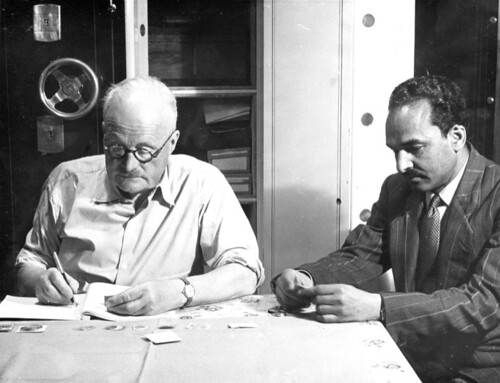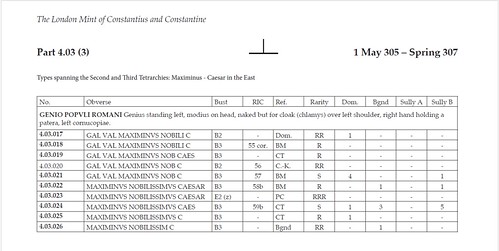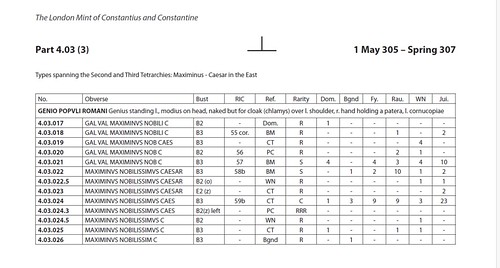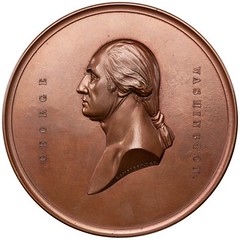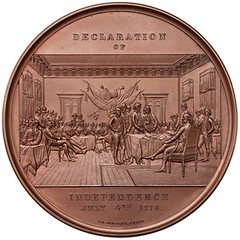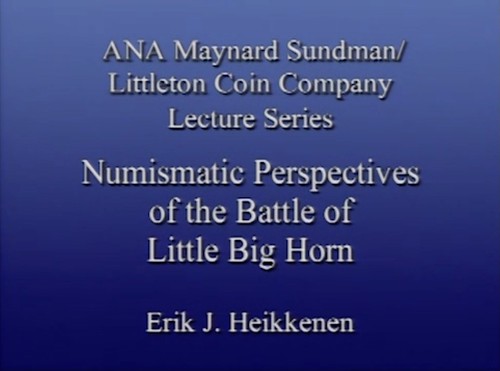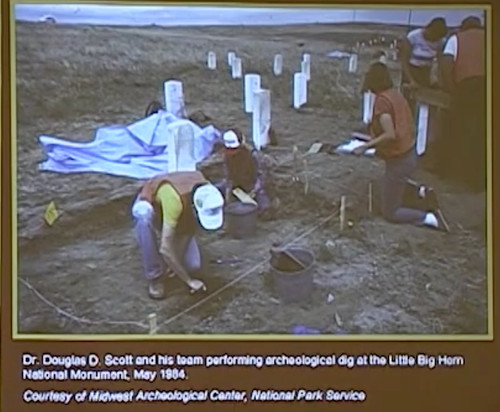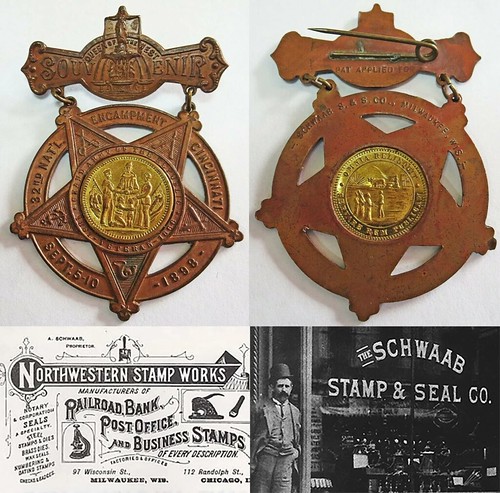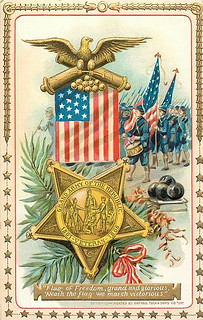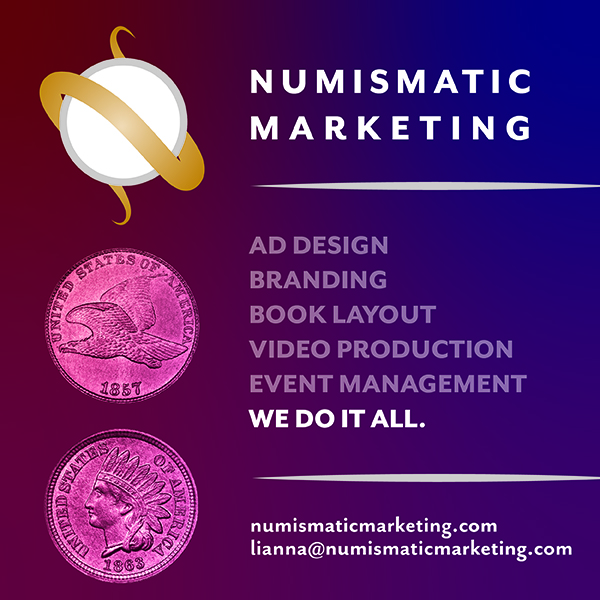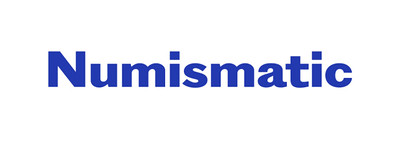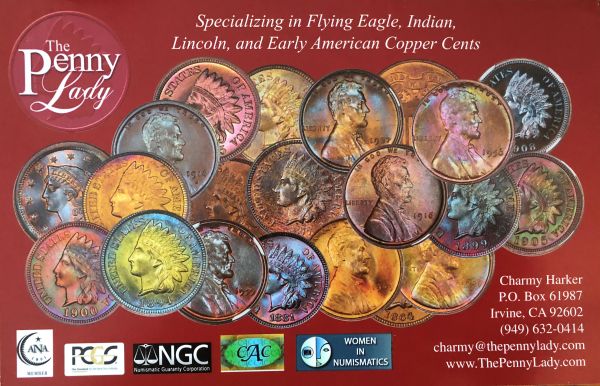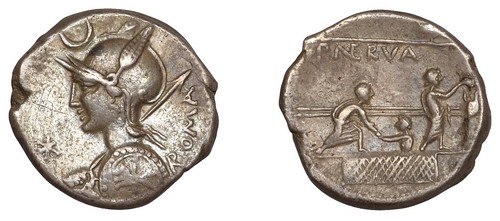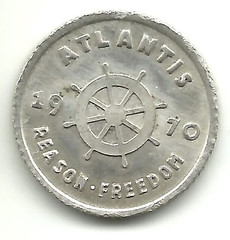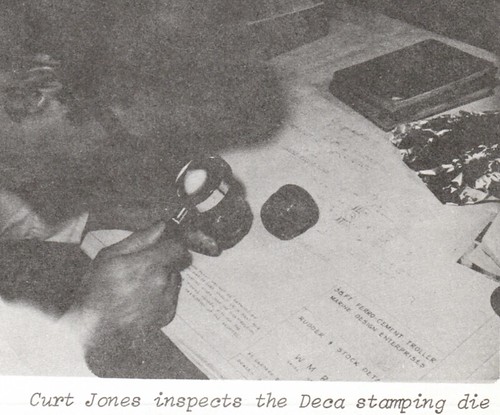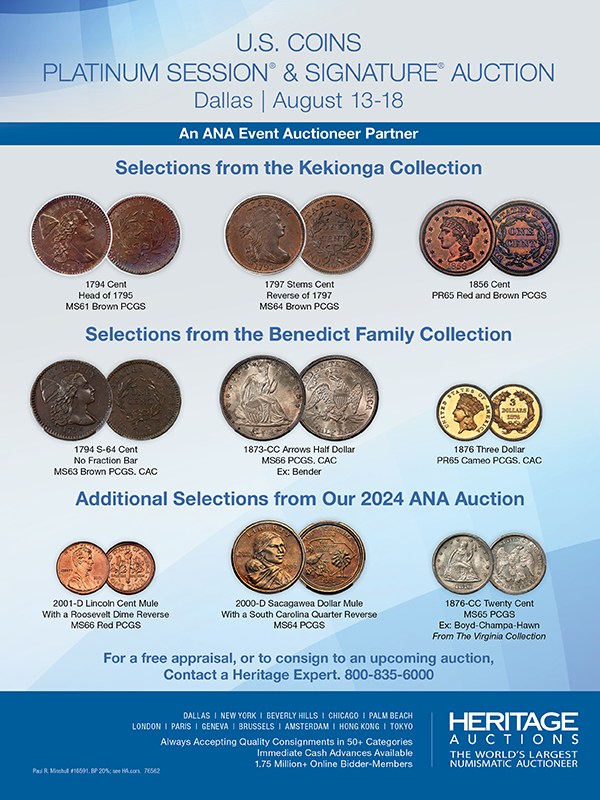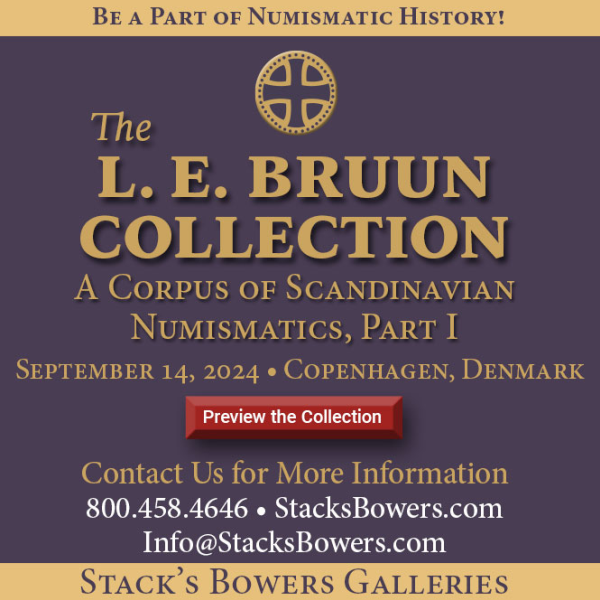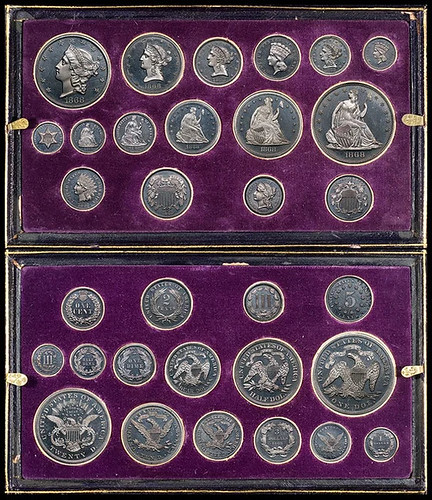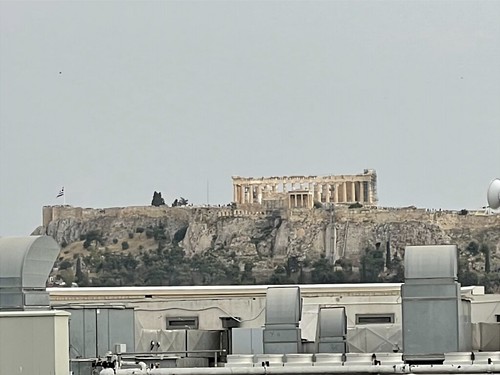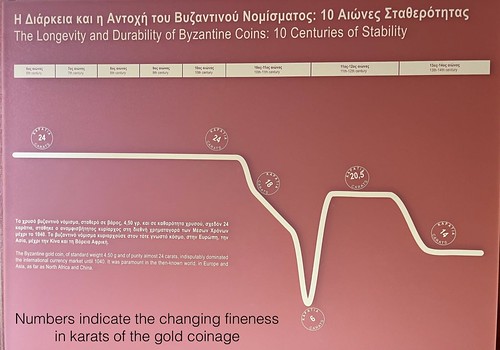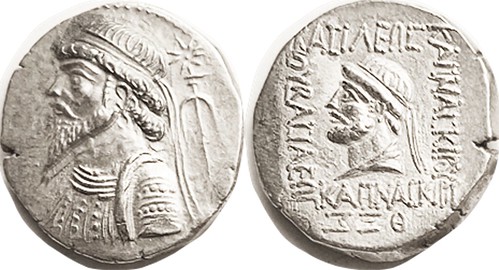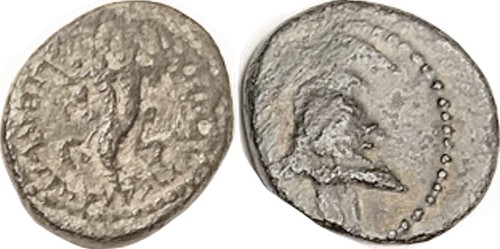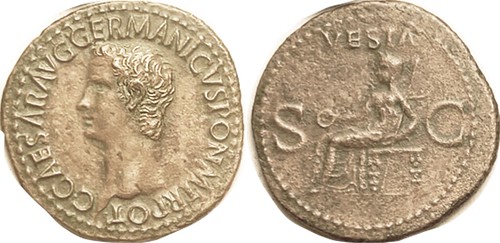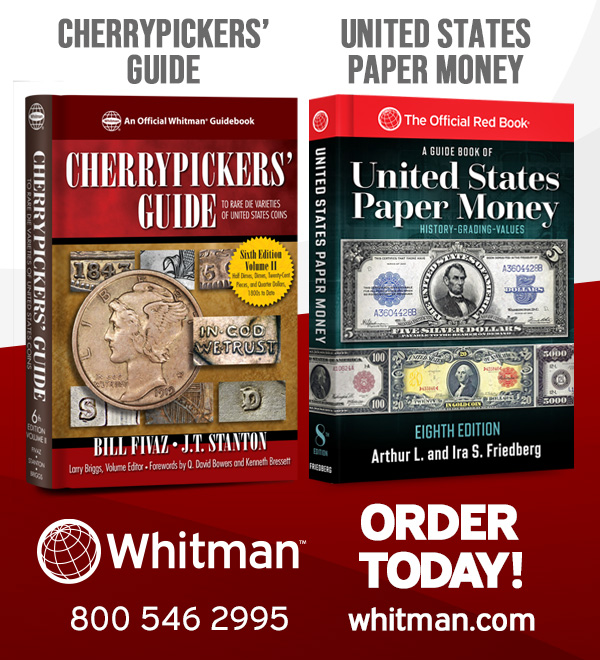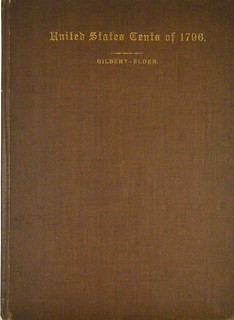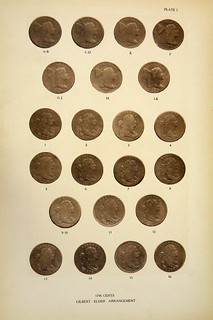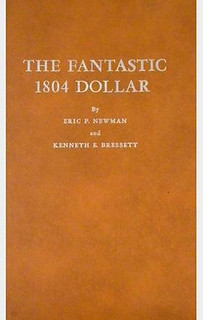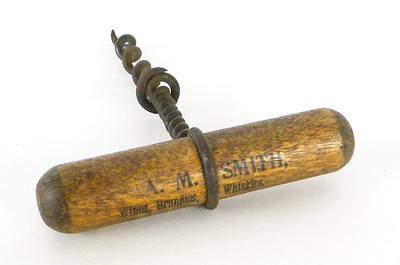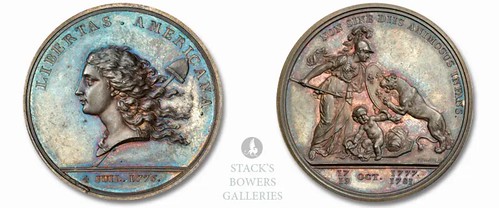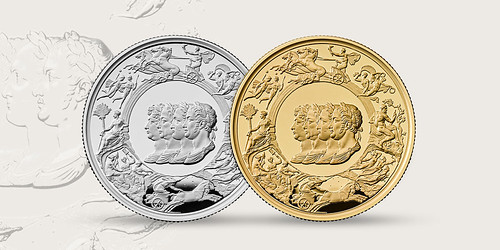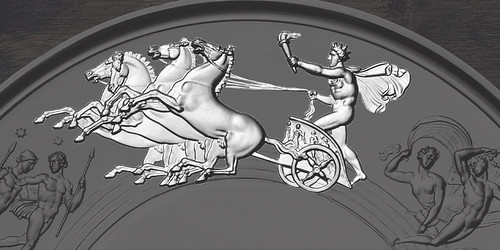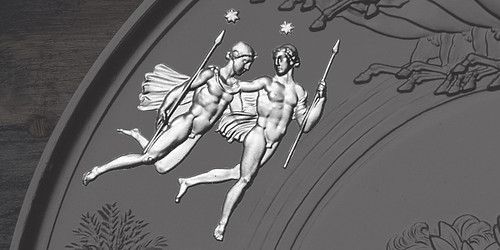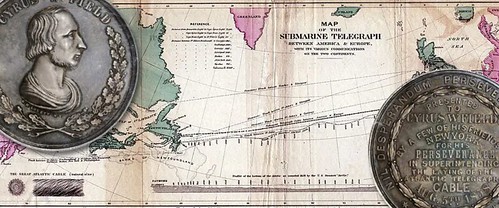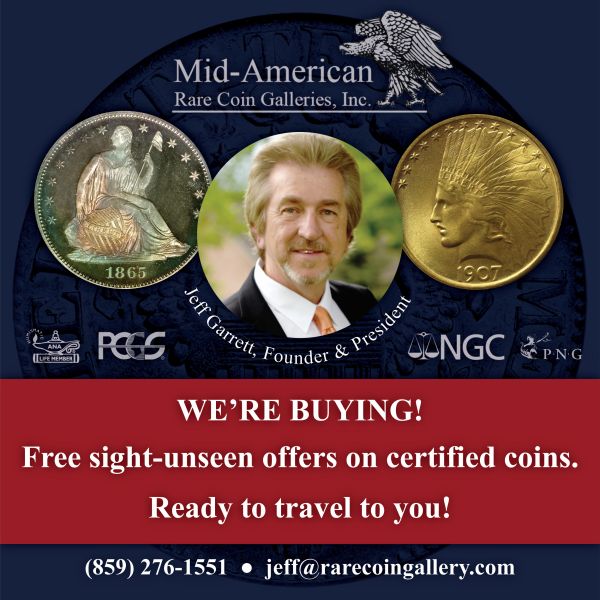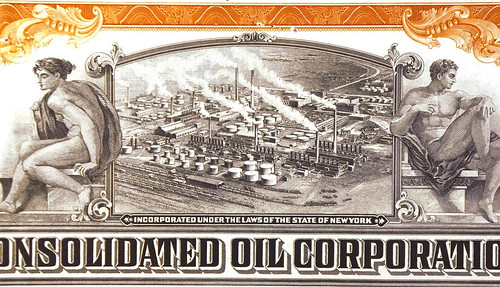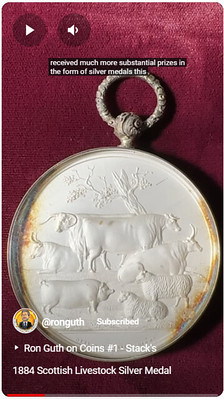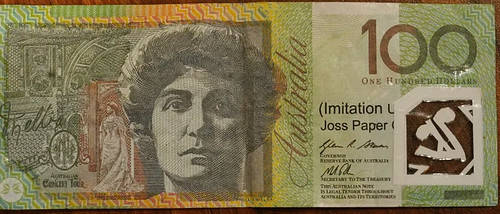
Visit our NBS Sponsors
About UsThe Numismatic Bibliomania Society is a non-profit association devoted to the study and enjoyment of numismatic literature. For more information please see our web site at coinbooks.org SubscriptionsThose wishing to become new E-Sylum subscribers (or wishing to Unsubscribe) can go to the following web page link MembershipThere is a membership application available on the web site Membership Application To join, print the application and return it with your check to the address printed on the application. Print/Digital membership is $40 to addresses in the U.S., and $60 elsewhere. A digital-only membership is available for $25. For those without web access, write to: Jeff Dickerson, Treasurer AsylumFor Asylum mailing address changes and other membership questions, contact Jeff at this email address: treasurer@coinbooks.org SubmissionsTo submit items for publication in The E-Sylum, write to the Editor at this address: whomren@gmail.com BUY THE BOOK BEFORE THE COINSale CalendarWatch here for updates! |
- WAYNE'S WORDS: THE E-SYLUM JUNE 30, 2024
- NEW BOOK: THE LONDON MINT, 2ND ED.
- NEW BOOK: NUMISMATIC LIBRARY OF SARAH SOPHIA BANKS
- WILLIAM MICHAEL HINKLE (1953-2024)
- C. C. WRIGHT DECLARATION OF INDEPENDENCE MEDALS
- VIDEO: NUMISMATICS OF LITTLE BIG HORN
- CINCINNATI GAR MEMBERSHIP BADGE
- NOTES FROM E-SYLUM READERS: JUNE 30, 2024
- VOTING ON COINS
- OPERATION ATLANTIS ONE DECA COIN
- VOCABULARY TERM: PORTRAIT MEDAL
- WHO WAS W. L. SHAW?
- STAN KESSELMAN INTERVIEW, PART TWO
- SARAH SOPHIA BANKS
- ANA HONORS NUMISMATIC ROLE MODELS
- DISPLAYS AT THE 2024 WORLD'S FAIR OF MONEY
- MIKE MARKOWITZ VISITS GREECE
- ANCIENT COINS FEATURED IN ROBINSON AUCTION
- WAYNE'S NUMISMATIC LITERATURE RESULTS
- A SILVER LIBERTAS AMERICANA MEDAL
- PISTRUCCI'S WATERLOO MEDAL
- AUGUSTUS SAGE'S CYRUS FIELD MEDAL
- FASCINATED BY OLD STOCK CERTIFICATES
- A VENDING MACHINE FOR MONEY
- LOOSE CHANGE: JUNE 30, 2024
Content presented in The E-Sylum is not necessarily researched or independently fact-checked, and views expressed do not necessarily represent those of the Numismatic Bibliomania Society.
WAYNE'S WORDS: THE E-SYLUM JUNE 30, 2024
 Thank you for reading The E-Sylum. If you enjoy it, please send me the email addresses of friends you think may enjoy it as well and I'll send them a subscription. Contact me at whomren@gmail.com anytime regarding your subscription, or questions, comments or suggestions about our content.
Thank you for reading The E-Sylum. If you enjoy it, please send me the email addresses of friends you think may enjoy it as well and I'll send them a subscription. Contact me at whomren@gmail.com anytime regarding your subscription, or questions, comments or suggestions about our content.
NOTE FOR THIS WEEK: I'll be traveling July 3-11, but my assistant Garrett Ziss will finalize the July 7th issue. While I'll still check email occasionally, PLEASE INCLUDE Garrett ( gzcbhd453@gmail.com) on correspondence this week and we'll do our best to pull together the issue as usual.
This week we open with two new books, an obituary, updates from the Newman Numismatic Portal, notes from readers, and more.
Other topics this week include Sarah Sophia Banks, Charles Cushing Wright, voting on coins, Operation Atlantis, portrait medals, W. L. Shaw, the Numismatic Museum of Athens, auction previews, some Kolbe & Fanning Sale 170 results, the Waterloo medal, scripophily, and ATMs.
To learn more about the London Mint of Constantius and Constantine, Mike Hinkle, Rick Snow, Declaration of Independence medals, GAR membership badges, cataloguing the Farouk sale, the one Deca silver coin, a 1933 double eagle, Sage's Cyrus Field medal, and risqué stock certificate vignettes, read on. Have a great week, everyone!
Wayne Homren
Editor, The E-Sylum
THE BOOK BAZARRE
NEW BOOK: THE LONDON MINT, 2ND ED.
Hugh Cloke writes:
"Spink has just posted the publication notice for the new edition of Lee Toone's and my The London Mint of Constantius and Constantine. This is the second of the three books to be celebrated at the York conference in July. The first book is Eleanor Ghey's study of Tetrarchic hoards. The third book is Sam Moorehead's upcoming volume of Roman Imperial Coinage on Carausius. That book will not be available by the July conference date."
 The London Mint of Constantius and Constantine, Second Edition
The London Mint of Constantius and Constantine, Second Edition
by Hubert J Cloke and Lee Toone, with Adrian B Marsden
£75.00
Hardback, jacketed, 297 x 210mm, 360 pages
This new edition of LMCC remains the comprehensive catalogue and survey of the coinage of the London mint from AD 296, when Constantius I recaptured Britain from the usurper, Allectus, to its closure in AD 325 when his son and successor, Constantine I, began to shift his power base to the East. LMCC II continues the authors' earlier expansion and revision of the London portions of Volumes VI and VII of The Roman Imperial Coinage by incorporating new types discovered since 2015 and expanding the census tables based on the population totals from several major new hoards. As Sam Moorhead notes in his foreword to this second edition, this catalogue is now recognised as the standard reference work on the London mint coins of this period and is used by both the British Museum and the Portable Antiquities Scheme when cataloguing these coins.
The four reference hoards listed in LMCC I are Domqueur, Bridgend, and Sully II A and B
The six reference hoards in LMCC II are Domqueur, Bridgend, Fyfield, Rauceby, Wold Newton, and Juillac. Complete catalogues of Fyfield, Rauceby, and Wold Newton are published in Eleanor Ghey's new BM book. The massive Juillac hoard of 23,000+ coins is not yet published, but Lee and I catalogued the 2,100+ London coins in the hoard and the coin totals listed in our census tables are based on our cataloguing notes. The coins from Sully II A and B are still listed in our new book in the notes for each coin type at the bottom of each page. So the reader can actually see coin totals from eight hoards.
Congratulations! See the links below for the earlier articles. Here's Sam Moorhead's Foreword to the book. Sam, now retired, was the National Finds Advisor for Iron Age and Roman Coins in the Department of Portable Antiquities and Treasure at the British Museum.] -Editor
It is a great privilege to write this short piece in honour of the Herculean work of Hubert Cloke and Lee Toone. Since its publication in 2015, The London Mint of Constantius and Constantine is a book that frequently comes off my shelf both at home and at the British Museum. It is the authority we use for the identification of London mint coins on the Portable Antiquities Scheme database (finds.org.uk) and it is frequently used to assist with the cataloguing of the numerous hoards which are worked on by Dr. Eleanor Ghey and other colleagues in the Dept of Coins and Medals. The London Mint is also an invaluable volume for collectors and those working in the trade….
One has to admire Cloke's and Toone's tenacity in seeking out new coins so as to upgrade their existing work. It would be very easy for them to have rested on their laurels and leave future additions to other scholars. In this respect, the authors are doing the numismatic world a double service. This work will stand the test of time and will be added to by future generations with a minimum of effort – what a legacy!
For more information, or to order, see:
The London Mint of Constantius and Constantine, Second Edition by Hubert J Cloke and Lee Toone, with Adrian B Marsden
(https://spinkbooks.com/products/the-london-mint-of-constantius-and-constantine-second-edition-by-hubert-j-cloke-and-lee-toone-with-adrian-b-marsden)
To read the earlier E-Sylum articles, see:
2024 BRITANNIA NUMMARIA CONFERENCE
(https://www.coinbooks.org/v27/esylum_v27n04a08.html)
NEW BOOK: TETRARCHIC HOARDS FROM ROMAN BRITAIN
(https://www.coinbooks.org/v27/esylum_v27n15a03.html)
NEW BOOK: NUMISMATIC LIBRARY OF SARAH SOPHIA BANKS
A new book published by the Royal Mint Museum examines the numismatic library of famed collector Sarah Sophia Banks. See an article elsewhere in this issue for more about the woman and he collection. -Editor
 The Numismatic Library of Sarah Sophia Banks
The Numismatic Library of Sarah Sophia Banks
by Edward Besly
Hardback, jacketed, 180 pages, 290 x 220mm
Sarah Sophia Banks (1744-1818) was a distinguished collector and numismatist. With the help of her librarian, Jonas Dryander, she built an important library of numismatic books, both new and antiquarian, notable particularly for covering medieval and what were then modern coinages, rather than those of ancient Greece and Rome; Sarah Banks also took a keen interest in the provincial token coinages of the 1780s and1790s. After her death, her library passed intact to the Royal Mint and it is presented here as categorised at the time by Jonas Dryander, as a contribution to the history of collecting and numismatic scholarship, with an essay by Hugh Pagan explaining the way in which Sarah Sophia Banks's library was assembled and the time span over which this was done.
Edward Besly FSA was from 1986 to 2018 Numismatist at the National Museum of Wales (Amgueddfa Cymru) having previously worked at the British Museum, Department of Coins and Medals. He is best-known for his studies of Romano-British coin hoards and of the coinages of the time of Charles I (1625-49). In 2003 he was awarded the John Sanford Saltus Medal by the British Numismatic Society.
For more information, or to order, see:
The Numismatic Library of Sarah Sophia Banks by Edward Besly
(https://spinkbooks.com/products/the-numismatic-library-of-sarah-sophia-banks)
The Numismatic Library of Sarah Sophia Banks
(https://www.douglassaville.com/search_results_detail.asp?ID=4088)
THE NUMISMATIC LIBRARY OF SARAH SOPHIA BANKS.
(https://www.numislit.com/pages/books/7362/edward-besly/the-numismatic-library-of-sarah-sophia-banks)
WILLIAM MICHAEL HINKLE (1953-2024)
Tom Mulvaney passed along word of the passing of Kentucky numismatist Mike Hinkle. An obituary (linked below) stated that he "...was considered to be in the top three in the world at grading U.S. rare coins." Here's a profile (courtesy the Newman Numismatic Portal) from the New England Rare Coin Galleries Inventory Selections, Number 53, April 16, 1979. -Editor
Don't let that relaxed Southern manner fool you. W. Mike Hinkle (Mike
to his clients) is a sharp, thoroughly professional numismatist who has spent
almost half of his life collecting, studying and dealing in rare U.S. coinage.
Mike was born in Lexington Kentucky. His first experiences in numismatics
began in 1966. At that time, silver coinage was being pulled from circulation
by the U.S. government. Mike decided it would be fun to collect examples of
these coins before they disappeared.
During the next few years, Mike's interest and experience in rare coins
grew rapidly. He frequented coin shows, bought and sold coins for high
school friends and, in 1971, made his first professional numismatic contact:
Jonathan Kern. Kern was so impressed with Mike's numismatic knowledge
and enthusiasm that he took Mike with him on business trips.
Upon graduation from high school, Mike enrolled at the University of
Kentucky. His education was temporarily interrupted, however, when, at the
tender age of 21, W. Mike Hinkle became Director of Sales for the Steve Ivy
Rare Coin Company. I learned a lot at Steve's. I gained the ability to service
all sorts of collector needs. I developed the capacity to survive the pressures
of a big coin company. And I gained particular expertise in Morgan Dollars,
Peace Dollars, rare gold and patterns. A lot of what I picked up then helps me
make the right decisions at NERCG now.
Mike left the Ivy Company to complete his education. He received a B.A.
in December of 1977 and, after marrying the former Elizabeth Cornn, he joined
NERCG in 1978. I like the New England area. It's a good place to study and
collect coins. It's historic. Besides, I knew the rare coin market was about to
take off. NERCG was one of the few places that had the facilities to take
advantage of that. There are some real numismatic geniuses here.
Mike feels that there are still some pitfalls to collecting rare coins, but
he's bullish about rare coins' investment potential. And he enjoys passing his
knowledge on to collectors. Collectors have got to be shrewd. And if they
haven't developed the expertise, they should find someone who has. Experts
keep you from getting trapped.
To read the New England Rare Coin Galleries article on NNP, see:
Inventory Selections: Number 53, April 16, 1979
(https://nnp.wustl.edu/library/book/553627?page=2)
"Mike was very active in the coin business, mainly with a firm in New England before the Coin Crash of 1980. I am sure many of the old timers will remember him. Although he lived in the area, he has not been active in coins for some time. I knew Mike, but not well. It's been many years since I've seen him."
Tony Terranova writes:
"Good people. Excellent coin dealer."
Jeff Garrett writes:
"Mike was a brilliant coin dealer starting in the 1970's. He was one of a few great coin dealers who grew up in Lexington Kentucky including Jon Kern and John Saunders. During his prime he handled many important coins and collections. A medical condition that developed in the 1980's sidelined him from the top ranks in the business. He continued to enjoy the hobby for decades afterwards. His quirky personality and excitement for the hobby will be missed by all who knew him."
Thanks, everyone. -Editor
To read the complete online obituary, see:
William Michael Hinkle October 14, 1953 - June 22, 2024
(https://www.kerrbrothers.com/obituaries/William-Michael-Hinkle?obId=32113101)
C. C. WRIGHT DECLARATION OF INDEPENDENCE MEDALS
Newman Numismatic Portal Project Coordinator Len Augsburger provided the following report. Great medals! -Editor
C. C. Wright Declaration of Independence Medals
The C. C. Wright Declaration of Independence Medals, GW-181 to GW-184, are among the most aesthetically pleasing in the entire American series. Neil Musante dates the medal to 1851, and examples appeared in auctions as early as October 16, 1865, where Edward Cogan (lot 1556), describes it as a very scarce medal.
A selection of these medals is currently on exhibit in St. Louis at Washington University's Olin Library, courtesy of the Resolute Americana collection, and will remain on view through July 7.
Images: American Numismatic Society bronze example of the Declaration medal, GW-181, ANS catalog no. 0000.999.39101.
Link to Cogan 1865 sale:
https://archive.org/details/catalogueofverye00coga_1
VIDEO: NUMISMATICS OF LITTLE BIG HORN
The David Lisot Video Library on the Newman Numismatic Portal can be found at:
https://nnp.wustl.edu/library/multimediadetail/522852
We highlight one of his videos each week in The E-Sylum. Here's one from 2005 that features Erik J. Heikkenen speaking about Numismatic Perspectives of the Battle of Little Big Horn. -Editor
This presentation features a historical perspective of the area of Little Big Horn and how discovery of gold affected its settlement, including:
- Why the Indians were uncooperative with the government
- Diagram of the battlefield
- Account of the battle by Wooden Leg, an Indian who told of finding money on the bodies of the dead soldiers
- Money and coins that were found
- How a fire in 1983 allowed excavation of the battle site and examples of what was discovered
Speaker(s): Erik J. Heikkenen. Publication date: August 20, 2005.
To watch the complete video, see:
Numismatic Perspectives of the Battle of Little Big Horn
(https://youtu.be/bKp52lIf0AM)
CINCINNATI GAR MEMBERSHIP BADGE
Last week Bob Fagaly asked about this token with a design relating to the Society of the Cincinnati. Readers were quick to respond. -Editor
Patrick McMahon writes:
"I saw the question about that token or medal with Cincinnatus on it. The image on the other side is the logo of the Grand Army of the Republic (G.A.R.) so this is probably associated with one of their encampments. The presence of Cincinnatus could be reference to the city of Cincinnati which hosted two of the G.A.R.'s national encampments in the 19th century (1869 and 1898—but the encampment continued until the 1940s so there could be more).
"I can find examples this medal being connected with Cincinnati online but not actual proof of that connection. There were also numerous local, annual encampments that took place and the range of different medals is bewildering!
"Here's a link to an explanation of the symbolism in the logo from the G.A.R. museum in Lynn, Massachusetts: https://garlynn.org/gar-emblem/
"Here's a link to the publication that goes with the 1898 encampment in Cincinnati. I can't find any mention of the medal but it includes a list of the encampments up to that year: https://archive.org/details/officialcincinna00cinc/page/n34/mode/1up "
Harry Waterson writes:
"The obverse image is from the Grand Army of the Republic (GAR) Membership Badge. The reverse image is from the souvenir medal for the GAR Encampment in Cincinnati in 1898. Bob Fagaly probably has the insert medal which came away from its 1898 souvenir surround. There are a number of these that can be found by Googling the Latin Legend. The GAR book by Floyd & Johnson is the standard reference work. Tom Casper has written the book on Schwaab"
Julia Casey writes:
"These pieces were the subject of a Collector's Universe message board post (c. 2018-2020) and were traced to being the inserts in G.A.R. encampment badges issued by Schwaab of Milwaukee."
Thanks, everyone! -Editor
To read the complete thread, see:
https://forums.collectors.com/discussion/1000115/is-this-a-civil-war-token
To read the earlier E-Sylum articles, see:
NEW BOOK: SCHWAAB STAMP & SEAL OBSOLETE DIES
(https://www.coinbooks.org/v25/esylum_v25n41a03.html)
NOTES FROM E-SYLUM READERS: JUNE 23, 2024 : Mystery Society of the Cincinnati Token
(https://www.coinbooks.org/v27/esylum_v27n25a08.html)
NOTES FROM E-SYLUM READERS: JUNE 30, 2024
The Collector's Disposition Dilemma
Last week Pete Smith discussed his extensive collection of A.M. Smith material, and sought advice from readers on how to dispose of such a specialized, local collection. -Editor
B.J. Herbison writes:
"I would first visit the Hennepin County Museum to see if a display case dedicated to Smith would fit in the museum. Then offer to give the items (or portion) to the museum if they create a permanent display case dedicated Smith. Offer to curate the case (but give them many items in addition to the items in the case). Make a financial contribution to go along with the item donation (the cost would be much less valuable than the time you have already invested).
"You only mentioned one museum, but I would look again for other museums or historical societies. Did Smith spend any period of time in other areas? Look there as well.
"In addition to museums, make similar offers to libraries in the area (since there is a book connection) or even town halls or schools -- they sometimes have displays.
"Did A.M. Smith have any descendants? I agree that the youngest might not be ready to take on a collection, but if you find a descendant with another type of collection they have the collectors bug and might be interested in including your Smith collection.
"If the collection does get split up, donating some of the items to the descendants would probably be appreciated.
"I wish you well in finding a satisfying distribution."
To read the earlier E-Sylum article, see:
THE COLLECTOR'S DISPOSITION DILEMMA
(https://www.coinbooks.org/v27/esylum_v27n25a11.html)
Cataloging the Farouk Sale
Daniel Fearon writes:
"The Stack's comments on the Farouk sale don't quite ring true. I have been in touch with Edward Baldwin and have more or less got to the bottom of it all.
"John Synge was Sotheby's coordinator in Cairo, responsible for organisation and logistics. He was no longer on the staff when I joined Sotheby's in October 1963. Edward Baldwin has copies of letters to him in Cairo from his father, Albert Baldwin, in London, relating to printing and photography. He wasn't a coin man at all. The coins etc were catalogued by Fred and Albert Baldwin. Fred started off but fell behind schedule due to the sheer quantity of the collection and the discomfort of working in the unairconditioned strong room in the Koubbeh Palace, so Albert went to help him out.
"Edward Baldwin did a little Google research, which has turned up the following scenario for this distortion of the facts. The story seems to have started with Time magazine, which told of John Synge's eleven months in Cairo sorting Farouk's "gimmicks". Stacks picked up on this and being coin people assumed all the "gimmicks" were coins. People forget there were four Sotheby catalogues for Farouk, including gold and silverware, paperweights and Galle glass as well as Objets de Vertu. Of course, Farouk's name doesn't appear on any of them.
"It should never be forgotten that up until 1968, Baldwin's were Sotheby's appointed coin and medal specialists. For the Farouk sale the Sotheby director they reported to was Tim Clarke.
"The catalogues were printed by Pardy's, who, of course, are still printing coin catalogues. The gravure plates were by the Chiswick Press. Interestingly a 5% surcharge was applied to all invoices - certainly the first outing of the buyer's premium by a British auction house."
Great photo. Thank you. -Editor
To read the earlier E-Sylum article, see:
ON FAROUK COLLECTION PAPER MONEY
(https://www.coinbooks.org/v27/esylum_v27n25a22.html)
Word of the Day: Numismatic
Bill Rosenblum passed along this Word of the Day for June 25th from the Word Daily newsletter. Thanks. -Editor
WORD ORIGIN
French, late 18th century
WHY THIS WORD?
Numismatic
comes from the French word numismatique,
which developed in Latin from the Greek word nomisma
(current coin
). The National Numismatic Collection at the Smithsonian National Museum of American History is thought to be the world's largest collection of money and transactional objects, totaling roughly 1.6 million objects. The collection, which started with a few thousand items in the mid-19th century, spans more than three millennia and represents every inhabited continent. It's grown to its impressive current size through donations from private collectors and public institutions.
To read the complete article, see:
Numismatic
(https://worddaily.com/words/Numismatic/)
More on William Bogle
 Julia Casey writes:
Julia Casey writes:
"I discovered that William Bogle was the father of Major Archibald Bogle who commanded the 35th US Colored Troops in the Civil War. Major Bogle was wounded and spent time in Andersonville. There is a lot about him online.
"William Bogle was "known to fame as the proprietor of 'Bogle's Magic Hair Dye'," and a contemporary wrote that Bogle "always used the stuff on his moustache and hair, and kept them in shape if his person was otherwise seedy."
Links:
https://battleofolustee.org/35th_usct.html
https://battleofolustee.org/letters/a_bogle_35th_usct-01.htm
https://www.findagrave.com/memorial/29929407/archibald-bogle
Interesting - thank you. -Editor
To read the earlier E-Sylum article, see:
1864 MASONIC ENGRAVED HALF DOLLAR OFFERED
(https://www.coinbooks.org/v27/esylum_v27n25a20.html)
VOTING ON COINS
With upcoming elections in the U.S. and U.K., David Pickup submitted this article about voting as depicted on coins. Thank you! -Editor
P. Nerva, Denarius, c. 113-112, helmeted head of Roma left, spear over shoulder, rev. voting scene within the comitium, 3.27g (Craw. 292/1; BMCRR Italy 526-8; RSC Licinia 7; RCV 169). Light scratch in field before face, otherwise very fine LOT 345 AUCTION 13 OCTOBER 2022 HAMMER PRICE £100
Great excitement! Britain has a General Election this week on 4th July. Electors choose their representative and the leader of the party that can command a majority in the House of Commons is invited by the King to form a government. All very polite and businesslike. When the next election will be held, no-one knows as the length of parliaments are not fixed. Perhaps an essential difference is in Britain candidates stand for election and in America they run for office. Whatever the similarities and differences, democracy is a right and a privilege that people given their lives for.
The election made me think of numismatics (and why not?). This denarius features a voting scene. Not much technology here and the electorate in Ancient Rome was small, limited to wealthy men, but this coin celebrates voting. Two figures on a bridge or perhaps the same individual before and after an attendant handing the voter a ballot or token to indicate his choice.
The Comitium was the original open-air public meeting space in Rome. The name comes from the Latin word for "assembly". The Comitium was at the northwest corner of the Forum. It was the location for much of the political and judicial activity of Rome and the meeting place of the Curiate , the earliest assembly of organised voting divisions of the Republic. During the Roman Republic, the Tribal Assembly and Plebeian Assembly met there. The Comitium was in front of the meeting house of the Roman Senate. The voting figures are set on a pons, (bridge) leading to the voting area. The bridge was placed there to isolate voters, I am not sure from the public or themselves.
This silver coin was minted in Rome, probably by Publius Licinius Nerva, in either 113 or 112 BC. Above the voting scene, is the inscription 'P. NERVA' referring to the moneyer. Above that is a bar on which stands a tablet bearing the letter P (too worn to see on this coin). Perhaps the letter P is a reminder who to vote for.
The obverse has ROMA, helmeted bust of Roma facing left, holding spear and shield, mark of value to left.
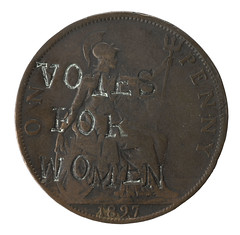 Other coins that refer to elections include the pennies stamped with the words VOTES FOR WOMEN in the 1910s supporting the Suffragette movement.
Other coins that refer to elections include the pennies stamped with the words VOTES FOR WOMEN in the 1910s supporting the Suffragette movement.
The 2003 50 pence coin commemorated the same campaign and in 2018 The Royal Mint released a 50p to commemorate the 100th Anniversary of The Representation of the People Act being passed. This legislation granted the vote to servicemen over the age of 19, to all men over the age of 21, and to women over the age of 30.
Some elections have been decided on the toss of a coin when the counting was too close to call.
I am sure there are other democracy and voting themed coins.
There are certainly tokens and medals issued by candidates and political parties. I'd be curious myself to learn of numismatic items related to voting itself. -Editor
Sources
- Wikipedia
- Foss. C., (1990). Roman Historical Coins, Seaby, London
To read earlier E-Sylum articles, see:
EXHIBIT: DEFACED! MONEY, CONFLICT, PROTEST
(https://www.coinbooks.org/v25/esylum_v25n41a12.html)
BALLOT BOX ON ROMAN COIN
(https://www.coinbooks.org/v27/esylum_v27n12a23.html)
LOOSE CHANGE: JUNE 23, 2024 : Biden-Trump Debate Format Settled by Coin Flip
(https://www.coinbooks.org/v27/esylum_v27n25a24.html)
OPERATION ATLANTIS ONE DECA COIN
We've made brief mention earlier of the micronation experiment "Operation Atlantis" and its coin, the "Deca," but I don't believe we've published images or other information. Recently eBay seller Roger Young posted one for sale - here's the listing. -Editor
Deca coin from Operation Atlantis 10 grams of 925 fine silver, 7/8" diameter 1/8" thick -- rare!
Operation Atlantis was a project started by Werner Stiefel in 1968 aiming to establish a new, libertarian nation in international waters. The operation launched a ferro-cement boat on the Hudson River in December 1971 and piloted it to an area near the Bahamas. Upon reaching its destination, it sank in a hurricane. After a number of subsequent failed attempts to construct a habitable sea platform and achieve sovereign status, the project was abandoned.
I have much data on Operation Atlantis as I was invited to join it and received most of the public printed matter pertaining to it which I would be happy to share with the buyer of this coin. There are very few of these coins available now.
At my request Roger kindly supplied some more information on the minting of the pieces from The Atlantis News newsletter published by Operation Atlantis promoters (Volume V, No. 5 September 4, 1970). Thank you! -Editor
After more than six months of designing, drafting, telephoning and negotiating, Curt Jones finally took delivery on the Deca coining dies on December 15, 1970.
Curt heads up our Deca minting project, one of the 14 programs we are pursuing more- or-less concurrently, which collectively comprise Operation Atlantis.
The problem, it will be recalled, lay in our unswerving resolution to own the dies ourselves rather than pursuing the conventional course of having a contract metal stamping firm own them. The entire Deca minting operation is to be done by ourselves, on our own equipment and without reliance on outsiders. Accordingly we will be able to move it to Atlantis III when the time comes.
The quality of the dies is less than we had hoped, and consequently the Decas struck with them will not exactly be masterpieces of the minting art, but they most assuredly will serve our purpose: commodity money with intrinsic value plus guaranteed weight and fineness.
Home stretch
Not much more remains to be done. An O-ring must be fabricated within which the upper and lower dies meet during the actual stamping operation. This job can readily be handled in his own shop by expert machinist Frank Traver. Then we need adaptors to hold the dies in the press, and that's it! Excitement runs high around Atlantis these days, and we hope to strike our first proud addition to the currencies of the world before the end of 1970.
Another item in the same issue details conversion between U.S. and Atlantic money. -Editor
We remind our readers and depositors that withdrawals from ATCOPS accounts may be made in either Deca coins or U.S. dollars. In the latter case there is a 1% charge for the conversion from Atlantis to U.S. money, and a check is then sent you for the net amount.
For withdrawals in Deca coins, there is no conversion charge, nor is there a charge for packing and handling. Postage and insurance are paid by you, however, and will be deducted from your account.
To read the complete eBay lot description, see:
Deca coin from Operation Atlantis 10 grams of 925 fine silver -- rare!
(https://www.ebay.com/itm/204856789963)
To read the earlier E-Sylum article, see:
MICRONATION STATECRAFT FOR DUMMIES
(https://www.coinbooks.org/esylum_v17n43a21.html)
VOCABULARY TERM: PORTRAIT MEDAL
Here's another entry from Dick Johnson's Encyclopedia of Coin and Medal Terminology. -Editor
Portrait Medal. A medallic item bearing a portrait as a principal device. Portraits are the most used device in medallic art, as these bas-relief objects record the achievements of man in all his activities. Portraits include bust and head, which reveal the facial characteristics for recognition, and full-length portraits even though the latter usually does not allow for recognition (because of small size in medallic items). Capturing the essence of the person is the most desirable task of the medalist, whether these portraits are engraved or modeled. Medallic portraits differ from a photographic or realistic likeness, as only the most talented medallic portrait artists can capture this essence.
Although medallic portraits are fairly democratic – anyone can have his portrait on a medal – usually only those individuals who have achieved the most outstanding human performance are honored with their portrait appearing on a medal. Pisanello's first medal was a portrait medal. It is as popular today as it was in 1539.
To read the complete entry on the Newman Numismatic Portal, see:
Portrait Medal
(https://nnp.wustl.edu/library/dictionarydetail/516527)
WHO WAS W. L. SHAW?
E-Sylum Feature Writer and American Numismatic Biographies author Pete Smith submitted this article on early American numismatists and terms describing them. Thanks! -Editor
In 1995 I received a copy of Numismatics in the News: Gleanings from Contemporary Newspapers. The compiler explored newspaper articles as a source for numismatic research.
Now I have a subscription to a service that provides access to many, but not all, of the country's newspapers. This is a very valuable tool for the type of research I do.
Occasionally there may be a question about the first time something was mentioned. This week I
looked into the first times the word numismatists
was found in this newspaper collection.
The first reference to numismatists
was published in The (London) Morning Chronicle for
February 25, 1834. This was an advertisement for Descriptive Catalogue of Rare and Unedited
Roman Coins by J. Y. Akerman, F.S.A. The book and Ackerman were mentioned in eighteen
additional articles in England in 1834.
The July 26, 1837. issue of The Philadelphia Inquirer used the word numismatists
for the first
time in an American paper. However, the article had been picked up from a British newspaper.
American papers continued to run articles based on stories from England and Europe.
The (London) Times had an ad dated February 20. 1851, offering a publication called The Numismatist. There was a similar ad in The Morning Chronicle for February 27, 1851. Did that ever succeed?
On March 20, 1851, Professor D. E. Groux ran an ad in the New York Daily Herald. He offered 4000 coins and medals for sale through a temporary location in New York. The name of Groux should be familiar to bibliophiles.
An ad was placed in the New York Tribune of May 22, 1852, by W. L. Shaw, a name unfamiliar to me. I wonder if the average reader of the paper knew what a numismatist is. More to the point, would the average coin collector in 1852 know what a numismatist is?
I contributed a listing of American Numismatic Pioneers
to the Summer 2004 issue of The
Asylum. W. L. Shaw was not included on the list.
Q. David Bowers compiled American Numismatics Before the Civil War 1760-1860, published in 1998. Bowers mentions Groux across several pages but does not mention Shaw.
The 1850 Census did not provide an obvious match.
The Boston City Directory for 1852 has three listings for William Shaw but none of them has the middle initial ‘L'.
Shaw expressed an interest in acquiring a cent dated 1815. Since none were produced, it is logical that he did not have one. What reference could a numismatist check in 1852 to learn that none were made?
By 1850, Boston had a population of 136,381. Would the Post Office have been able to deliver mail without a first name or a street address? They couldn't look him up in the city directory.
The American hobby of numismatics changed in 1857. This was mentioned in newspapers of the time. An article in the Daily Evening Express for May 26, 1857, mentioned new cents being exchanged for old at the Philadelphia Mint.
This new coin, which promptly made its appearance in town yesterday in considerable
quantities, was the general topic of conversation. … To accommodate the crowds of people who,
it was thought, would present themselves, a temporary wooden structure, having two windows,
was erected in the yard of the Mint. At one window was received the copper coins brought for
redemption; at the other the silver. Of course, only a portion of them desiring the new coin could
then obtain an opportunity of procuring it, owing to the pressure of the crowds; yet, in a day or
two there is no doubt that the supply will be amply sufficient to meet all the demands, From this
date, copper cents will pass out of existence with such rapidity that the entire stock will remain in
the hands of numismatists and virtuosos.
The October 7, 1857, issue of (Philadelphia) Public Ledger offered, A collection of CENTS,
from 1793 to 1857, inclusive. (1815 included).
In 1857 and 1858, additional ads ran in Public Ledger offering coins and U. S. pennies for sale. Replies were to be addressed to C. W. at the Ledger office. This may have been Charles Warner, a known dealer of the period.
I tried a search for similar terms like coin collector, coin collection and coin dealer. This proved to be quite frustrating. The site gave me matches to "corn", "comm" and even "coffin". There were too many false hits to justify continued searching.
It would appear, anyway, that the term 'numismatist' eventually caught on while the term 'virtuosos' has faded from usage.
Great topic. Has anyone else run into the name 'W. L. Shaw' ? Numismatic bibliophiles - are there books or catalogs in your library with Shaw's name? Collectors - any coins with a pedigree to Shaw? -Editor
To read the earlier E-Sylum articles, see:
NUMISMATIC GLEANINGS FROM CONTEMPORARY NEWSPAPERS
(https://www.coinbooks.org/esylum_v13n42a11.html)
NEWMAN PORTAL: SELLING COINS BY LOTTERYs
(https://www.coinbooks.org/v21/esylum_v21n22a11.html)
STAN KESSELMAN INTERVIEW, PART TWO
Greg Bennick's latest interview for the Newman Numismatic Portal is with New York dealer Stan Kesselman. Here's the second part, where Stan talks about financial times in 1973, and buying gold coins including a 1933 double eagle. -Editor
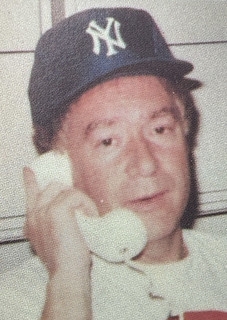 STANLEY KESSELMAN: So, it's now 1973. And Ted Naftzger calls. 1973 is a very bad year for the financial country.
STANLEY KESSELMAN: So, it's now 1973. And Ted Naftzger calls. 1973 is a very bad year for the financial country.
GREG BENNICK: Yeah, that's true.
STANLEY KESSELMAN: The Dow went from maybe 950 down to 480. The stock were paying nine and ten percent dividends because they were riskier than bonds. And we had a gasoline crisis. And Ted Naftzger calls, he needs money. He borrowed money from Wells Fargo. And I never heard of this before. Every three years from Wells Fargo, they made him repay the loan. And as soon as he repaid the loan, he can go out and borrow it all over again. The next day, the next hour, they just wanted to see he could repay it.
And it was 1973. And the cattle business was horrible. It costs more to feed the cattle than he could sell them for. So, he said he had to go sell his coins. So, I call Mike Brownlee up in Dallas. Michael had the customer to buy this. And Julian, since he was so nice to me over the years, I said, let's go to Beverly Hills. We'll meet Ted Naftzger. And we'll try and make a deal to buy his $20 gold coins. And Mike Brownlee brought his customer. His name was Jeff Browning. I don't know if you've ever heard of Jeff Browning.
GREG BENNICK: I have, yeah, I have.
STANLEY KESSELMAN: Jeff Browning was one of seven children. The parents died and they divided the land up into sevenths. They put in the hat the number of your lot. And he put their hands in the hat. The best lot was the one with the house on it. The other was all prairie and desert. So, Jeffery got the prairie and desert, but they discover oil on his land on the prairie and desert and Jeff Browning in 1973 was taking in around $450,000 a month. Which then was pretty big money.
GREG BENNICK: It's still big money, it's amazing.
STANLEY KESSELMAN: Okay, so he was the customer and he flew with Mike Brownlee to Beverly Hills. So, four of us were there, Julian, Mike Brownlee, myself and Jeff Browning. So, I take a room for Michael and myself, Julian has his own room and Jeff Browning has his own room. I'm the first one to arrive. I arrived there the room is freezing; the window had an air conditioner in it and the air conditioner was no longer there. So, you could not shut the window. So, I am totally freezing, the air's coming in, I get into bed and I'm wearing a suit with a tie. I go to sleep with my suit on, I loosen the tie.
So, there I am in the room, Mike Brownlee comes in later. He sees me sleeping there, he doesn't say too much. He takes off all his clothes and he sleeps absolutely nude. I didn't understand this at all, the room is freezing. So now I'm meeting Ted Naftzger downstairs in the coffee shop at nine o'clock, it's 8.30. He says, Kesselman, get out of bed you got to go shower and shave for this meeting. I'm still groggy, I said, Don't bother me.
So now it's five to nine, he's fully dressed he pulls the covers down off of me and I'm wearing my suit and tie. So, I look in the mirror, I tighten my tie and said Michael let's go. He couldn't believe I was fully dressed.
GREG BENNICK: That's amazing, I love that the reveal of you being fully dressed and ready for the meeting within 10 minutes, that's great.
STANLEY KESSELMAN: Right, I guess the smell didn't count, but off we went. So now Julian wanted to come to the meeting. I said, You can't come,
because we'd be three against one and that doesn't look good. You stay in the room and we'll see what happens. So, Michael and I go to Ted Naftzger's office, he takes out he's only selling now his liberty $20 gold. He's keeping his St Gaudens.
GREG BENNICK: Got it.
STANLEY KESSELMAN: So, it's 1850 through 1907 and he has every coin which he's upgraded. So, we had the calculators then, the first calculator made was a Bowmar Brain and that's what we had. So, Michael works it up and Ted Naftzger says he wants $250,000. Michael works it up on the Bowmar. He says, we can pay $175,000.
So, Michael works it up again. He comes up with $175,000. That's the most we can pay. Now, you have to remember, we had the buyer for this already in Beverly Hills in the hotel room. So Ted Naftzger says, I'm not going to sell it less than $250,000. I took years to put it together, and I don't care, $250,000 is the price.
So, I said, Michael, let me have the Bowmar Brain. Let me work it out.
And I stopped putting in numbers. I put in more numbers. I put in more numbers. And I say now, I just figured out how to buy this set of gold coins.
And Michael Brownlee says, Terrific.
And Ted Naftzger says, Terrific.
So, Michael says, How do we buy them?
I said, It's simple. Pay the guy the $250,000.
You know, we weren't going to leave, because we had the buyer there. So now everybody's happy. And we give him three checks, one from me, one from Julian, and one from Michael. And he gives us the coins. Michael takes the coins through Jeff Browning. And I think Jeff Browning gave us, I'm trying to remember the number. I think we made maybe $30,000 each, which was a hell of a lot of money back then. I never made $30,000 in my life in a deal.
And I came back to New York. And a few days later, Ted Naftzger calls. My check bounced. I didn't have enough money in the bank. He didn't care. I said, you know, go put it back. He put it in too soon. Whatever. I said, put it in again. And it cleared. But yeah. Well, Mike Brownlee and Johnny Rowe together had much more capital than I did. And Julian we owed a favor to.
And then the last part of the story is 1973 got so bad, he called, Ted Naftzger calls again and says he wants to sell the St. Gaudens 20s. He has to sell them. So, we go down. I said, Julian, make your reservation. We're going back to Beverly Hills. Michael, make the reservation. We're going back to Beverly Hills.
And Jeff Brownlee came back to Beverly Hills. And we bought the St. Gaudens 20s. I think the 1927-D he did not have. We paid maybe $225,000 for them. St. Gaudens 20s.
But then he took out another coin. He says, I can sell you this one. And I open it up and it seems to be a 1933 $20 in maybe 65 grade. And I'm looking at the thing. I'd never seen one before. And he tells me he bought it from Abe Kossoff. He says he's not sure it's legal to own, which we understood. And he wanted $50,000 for it. So, we threw that into the deal.
GREG BENNICK: Wow.
STANLEY KESSELMAN: And we gave it to Jeff Browning and we told him he couldn't tell anybody about it. But he really wanted to own it. And he could definitely afford it. Because you're talking about two weeks' money for him.
GREG BENNICK: Yeah. Amazing.
STANLEY KESSELMAN: I took the 1933 in my pocket for a while to have a good time. There was a coin convention out there at the time. And I'm sure you heard of Paul Nugget. And he was a big coin dealer in gold coins. He worked for MTB. And he worked for Stacks later on. And I showed the coin to him and he sort of went bananas. That he had it in his hand, the real 1933, twenty. Eventually the coin ended up with the government.
GREG BENNICK: And you were carrying it around as a pocket piece?
STANLEY KESSELMAN: Not for long. Maybe an hour in the convention room.
GREG BENNICK: All right.
STANLEY KESSELMAN: But eventually I think they surrendered the coin to the government after having it.
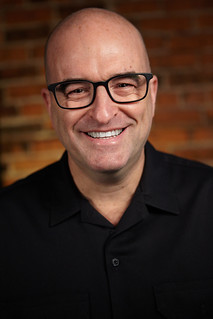 About the Interviewer
About the Interviewer
Greg Bennick (www.gregbennick.com) is a keynote speaker and long time coin collector with a focus on major mint error coins. Have ideas for other interviewees? Contact him anytime on the web or via instagram @minterrors.
To watch the complete video, see:
Stanley Kesselman Interviewed for the NNP by Greg Bennick
(https://nnp.wustl.edu/library/book/638521)
To read the complete transcript, see:
Stanley Kesselman Interviewed for the NNP by Greg Bennick (Transcript)
(https://nnp.wustl.edu/library/book/638520)
To read the earlier E-Sylum article, see:
STANLEY KESSELMAN INTERVIEW, PART ONE
(https://www.coinbooks.org/v27/esylum_v27n25a06.html)
SARAH SOPHIA BANKS
An article elsewhere in this issue announces a new book on the numismatic library of Sarah Sophia Banks. Here's an excerpt of a 2023 article about her by Catherine Eagleton, former Curator of Modern Money at the British Museum. -Editor
 When Sarah Sophia Banks died in September 1818 – as a result of a carriage accident on returning home from dinner – her obituary in the Gentleman's Magazine in November described her love of natural history, and explained that her collections had been presented to the British Museum. These collections, although less well-known than her brother's huge collection of botanical and other specimens, were also extensive. From the 1770s onwards, she had collected coins, medals and tokens, as well as prints and printed ephemera, and the collections at her death numbered more than 30,000 objects. Now split between the British Museum, British Library, and Royal Mint Museum, they give us remarkable insights into the life and interests of Sarah Sophia.
When Sarah Sophia Banks died in September 1818 – as a result of a carriage accident on returning home from dinner – her obituary in the Gentleman's Magazine in November described her love of natural history, and explained that her collections had been presented to the British Museum. These collections, although less well-known than her brother's huge collection of botanical and other specimens, were also extensive. From the 1770s onwards, she had collected coins, medals and tokens, as well as prints and printed ephemera, and the collections at her death numbered more than 30,000 objects. Now split between the British Museum, British Library, and Royal Mint Museum, they give us remarkable insights into the life and interests of Sarah Sophia.
The numismatic collection included around 9,000 objects, as well as a large library. Sarah Sophia was particularly interested in collecting contemporary objects – a contrast to other collectors at the time, many of whom focussed on ancient coins. Joseph Banks, of course, was also interested in contemporary coinage, through his work on the Privy Council Committee on Coin, but his sister's numismatic collection dwarfed his – he had only 100 coins and medals in it at his death.
In 1791, Sarah Sophia began to systematically list who gave her objects for her numismatic collection, as well as the people to whom she gave coins, tokens, or medals. These remarkable lists of the provenance of more than 8,500 objects were compiled up to her death, and provide a remarkable resource. It is possible to identify more than 500 individuals, ranging from Princess Elizabeth, to Mr Vacary the Porter, and of course including Joseph Banks, who gave her about 1,600 objects. As well as acquiring objects as donations from friends and correspondents, Sarah Sophia also bought objects for her collections, and gave coins, medals and tokens to other people, keeping lists of these as well as the lists of donations to her.
As well as collecting the objects themselves, Sarah Sophia collected and recorded information about them, keeping scraps cut out from newspapers, as well as memoranda of things told to her by her contacts and her brother's correspondents. She, like her brother, was interested in archaeology, and occasionally recorded where objects were found or dug up. Some of the information preserved in these newspaper clippings and notes is available from no other source – details of who made particular tokens or medals, and when, for what purpose the objects were used, or when they were collected.
The numismatic collections were stored in wooden cabinets, in her bedroom on the first floor of the house at 32 Soho Square. As an aid to finding objects, Sarah Sophia compiled a catalogue of her collection in about 1815, in 7 volumes. This shows us that the objects in her collection were organised geographically, beginning with coins from England, before moving on to Europe, Africa, the Middle East, Asia, and the Americas. Within each country, the coins were organised according to the rulers and the metals from which they were made. So, in a similar way to that in which Joseph's collections organised and classified the natural world, so Sarah Sophia's numismatic collection organised and classified the political world, through its rulers and the currencies they issued.
Today, Sarah Sophia's numismatic collections are an exceptionally rich resource for understanding the history of collecting of coins, tokens, and medals. The information she collected about them tells us about the contexts in which these objects were made, used, collected, and understood – in some cases, information that is available from no other source. Moreover, the collections also give us a way to learn about Sarah Sophia Banks herself, who would otherwise be so difficult to disentangle from her much more famous brother.
To read the complete article, see:
https://www.joseph-banks.org.uk/research-papers/annual-lecture-2013/
(https://www.joseph-banks.org.uk/research-papers/annual-lecture-2013/)
To read earlier E-Sylum articles, see:
SARAH SOPHIA BANKS (1744-1818)
https://www.coinbooks.org/esylum_v14n11a07.html
MORE ON SARAH SOPHIA BANKS
(https://www.coinbooks.org/esylum_v14n12a09.html)
SARAH SOPHIA BANKS AND THE ‘CONTINENTAL DOLLAR'
(https://www.coinbooks.org/v24/esylum_v24n03a33.html)
ANA HONORS NUMISMATIC ROLE MODELS
Congratulations to the winners of this year's ANA awards. -Editor
Numismatic Role Models to be Recognized During Celebration Events at World's Fair of Money in Chicago
The American Numismatic Association (ANA) is recognizing leading role models in the numismatic community that have exhibited an influential, and positive presence. The Outstanding Adult Advisor and Outstanding District Representative will be awarded during the Chicago World's Fair of Money® Member Awards and Donor Celebration, Thursday, Aug. 8 from 3-4:30 p.m. in room 25/26 at the Donald E. Stephens Convention Center. The ANA Dealer of the Year will be awarded at the convention's 133rd Anniversary Awards Banquet, Friday, Aug. 9 from 7-10 p.m. in the Grand Ballroom at the Hilton Rosemont/Chicago O'Hare hotel.
 The 2024 Harry J. Forman Dealer of the Year is Richard "Rick" Snow. The award recognizes a professional numismatist who shows uncommon dedication to strengthening the hobby and the ANA; exhibits high ethical standards and integrity; and is committed to treating customers fairly and consistently.
The 2024 Harry J. Forman Dealer of the Year is Richard "Rick" Snow. The award recognizes a professional numismatist who shows uncommon dedication to strengthening the hobby and the ANA; exhibits high ethical standards and integrity; and is committed to treating customers fairly and consistently.
U.S. small cents of 1857-1909 are Snow's specialty. His concern for the collector is evident at his shop, Eagle Eye Rare Coins, in Tucson, Arizona. When they opened 32 years ago, Snow and his business partner began reevaluating cents graded by third parties. They attach a sticker to the holder of those they agree have the proper designation. This became the model for Certified Acceptance Corporation (CAC)'s "green bean" stickers.
 In 1990 Snow founded the Flying Eagle and Indian Cent Collectors' Society (aka the "Fly-In-Club"), which has around 400 members. He has also authored several books on the topic and teaches regularly at the ANA's Summer Seminar in Colorado Springs.
In 1990 Snow founded the Flying Eagle and Indian Cent Collectors' Society (aka the "Fly-In-Club"), which has around 400 members. He has also authored several books on the topic and teaches regularly at the ANA's Summer Seminar in Colorado Springs.
Pam Stitely is the recipient of the ANA's 2024 Lawrence J. Gentile Sr. Memorial Award for Outstanding Adult Advisor. A well-respected hobby leader, Stitely developed a successful mentoring program for the Wilmington Coin Club of Delaware. Thousands have participated in the program over the past 20 years, including three of the past five of the ANA's Young Numismatists of the Year. She has also led numismatic programs for Boy and Girl Scouts and for the blind community.
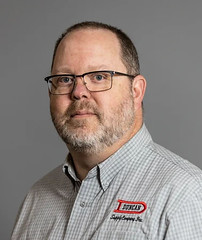 Outstanding District Representative Christopher Bower is a dynamo of hobby participation. As an ANA district representative for central Indiana, he has visited every member club within 50 miles of his home and some that are further afield. He promotes the ANA at conventions, special events, and online venues. He is especially successful at recruiting young collectors and hands out Buffalo nickels to any youngster he meets.
Outstanding District Representative Christopher Bower is a dynamo of hobby participation. As an ANA district representative for central Indiana, he has visited every member club within 50 miles of his home and some that are further afield. He promotes the ANA at conventions, special events, and online venues. He is especially successful at recruiting young collectors and hands out Buffalo nickels to any youngster he meets.
The American Numismatic Association is a congressionally chartered, nonprofit educational organization dedicated to encouraging the study and collection of coins and related items. The ANA helps its members and the public discover and explore the world of money through its vast array of educational and outreach programs, to include its museum, library, publications, conventions and webinars. For more information, call 719-632-2646 or visit money.org.
DISPLAYS AT THE 2024 WORLD'S FAIR OF MONEY
The ANA World's Fair of Money® will be here before we know it. Here are some of the great exhibits to look forward to. -Editor
Multi-million-dollar exhibits of historic numismatic treasures, some on public display together for the first time, will be among the many highlights of the American Numismatic Association's (ANA) 2024 Chicago World's Fair of Money® (WorldsFairofMoney.com) in Rosemont, Illinois, August 6-10. ANA members are encouraged to pre-register for the show to skip the registration line. Pre-registration ends July 12.
 "The finest known 1794 Flowing Hair dollar, believed by many experts to be the first silver dollar struck by the young United States Mint, will be displayed for perhaps the last time for years to come. Insured for $15 million, it is going into a private collection after the convention," said ANA Executive Director Kim Kiick.
"The finest known 1794 Flowing Hair dollar, believed by many experts to be the first silver dollar struck by the young United States Mint, will be displayed for perhaps the last time for years to come. Insured for $15 million, it is going into a private collection after the convention," said ANA Executive Director Kim Kiick.
The 1794 dollar, as well as a rare gold 1861 Paquet Reverse Double Eagle, and the most complete collection of Red Seal National Bank Notes, all with serial number one, will be part of a $30 million display courtesy of Ian Russell of GreatCollections (GreatCollections.com), the ANA's Official Auctioneer.
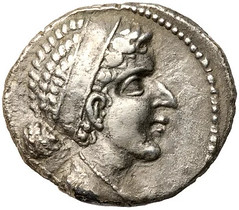 Visitors can also see for the first time another portion of the extensive Tyrant Collection (TheTyrantCollection.com), described as the most valuable rare collection in private hands. California collector Dan O'Dowd, in conjunction with Goldberg Coins and Collectibles of Los Angeles, will have a $5 million "Tyrants of the Nile" exhibit of more than 350 superb-quality Egyptian rare coins dating back 2,300 years. It will include coins depicting the ancient world's most famous queen, the legendary Cleopatra VII.
Visitors can also see for the first time another portion of the extensive Tyrant Collection (TheTyrantCollection.com), described as the most valuable rare collection in private hands. California collector Dan O'Dowd, in conjunction with Goldberg Coins and Collectibles of Los Angeles, will have a $5 million "Tyrants of the Nile" exhibit of more than 350 superb-quality Egyptian rare coins dating back 2,300 years. It will include coins depicting the ancient world's most famous queen, the legendary Cleopatra VII.
Selected pieces from the ANA Edward C. Rochette Money Museum will be on display, including ancient coins of Parthia and the McDermott-Bebee 1913 Liberty Head nickel. The Museum Showcase will also feature Florida collector Ron Firman's Mint Red 1943 bronze Lincoln cent and a 1944 cent mistakenly struck on a zinc-coated steel planchet from the previous year.
"There will also be two sets of United States Pattern Coins from the Black Cat Collection," including the only remaining complete 16-coin 1868 aluminum die trial proof set. There also is a complete six-coin copper and silver proof set of the 1882 Liberty Head Shield Earring patterns in 25-cent, 50-cent, and $1 denominations," said ANA Museum Curator Doug Mudd. "Those important pattern coins are courtesy of Legend Numismatics of Lincroft, New Jersey, and the anonymous owner of the Black Cat Collection."
The unique Experimental Finish 1910 Saint-Gaudens Double Eagle discovered in 2006, and one of the two known Satin Finish Proof 1921 Saint-Gaudens Double Eagles, will be displayed together for only the second time. The coins are being loaned to the ANA by Brian Hendelson, president of Classic Coin Company of Bridgewater, New Jersey (ClassicCoinCompany.com).
"Paper money collectors will want to see the display of Bank of the United States banknotes from a recent donation by long-time ANA advocates John and Nancy Wilson of Florida," stated Mudd. "The exhibit also will include checks signed by President Andrew Jackson and Winfield 'Old Fuss and Feathers' Scott, a former Commanding General of the United States Army and the 1852 presidential nominee of the Whig Party."
Special room rates are available, while rooms last, at two hotels near the convention center – the Hyatt Regency O'Hare and the Hilton Rosemont/Chicago O'Hare. Reservations must be made by July 14, 2024, to qualify for the rate.
For additional information about the ANA 2024 Chicago World's Fair of Money and lodging, visit WorldsFairofMoney.com.
The American Numismatic Association is a congressionally chartered, nonprofit educational organization dedicated to encouraging the study and collection of coins and related items. The ANA helps its members and the public discover and explore the world of money through its vast array of educational and outreach programs, to include its museum, library, publications, conventions and webinars. For more information, call 719-632-2646 or visit money.org.
MIKE MARKOWITZ VISITS GREECE
Mike Markowitz recently visited Greece and prepared a presentation for the Ancient Numismatic Society of Washington, DC. He shared is with us for The E-Sylum. Thanks - great trip! -Editor
The Numismatic Museum of Athens is in the mansion built by Heinrich Schliemann (1822-1890) the discoverer of Troy.
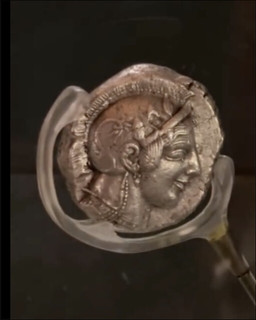

Star of the collection, the dekadrachm of Athens, mounted
on a rotating stand, so visitors can view both sides
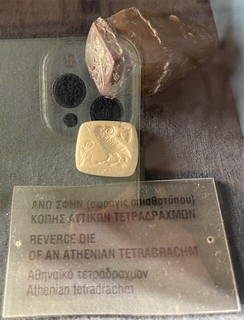
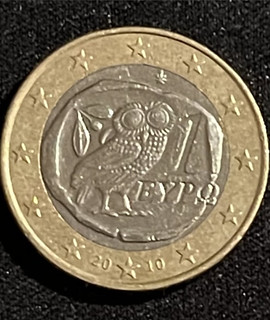
LEFT: a rare surviving coin die used to strike Athenian tetradrachms
RIGHT: Tetradrachm of Athens on the modern Greek €1 coin
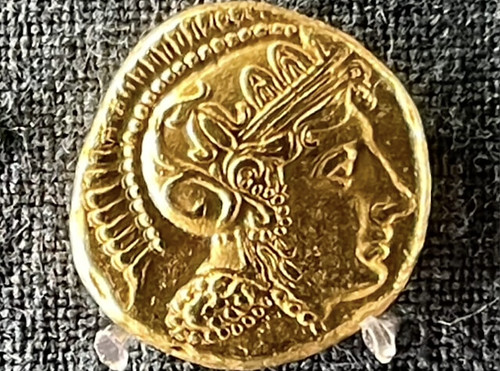
This is one of only four gold staters known from the emergency coinage issued
in 406 BC by Athens at then end of the Peloponnesian War. After the disastrous
Sicilian expedition in 413 BC and the Spartan capture of Deceleia in Attica,
the silver mines of Laurion were no longer accessible and Athens resorted to
striking gold stripped from the statue of Athena in the Parthenon.
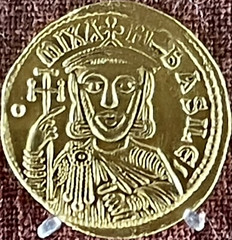

Two examples of the coin at the top of Mike's wish list:
Gold solidus of Michael I Rhangabe (Constantinople 811-813)
ANCIENT COINS FEATURED IN ROBINSON AUCTION
Here's the press release for Frank Robinson's upcoming sale. Always some interesting material. See lots 585-610 for some numismatic literature. -Editor
Dealer Frank S. Robinson will conduct his 125th mail and internet auction of Ancient and Early Coins with a closing date of August 1. The sale will include 610 lots, low minimum bids, and bids to be reduced as competition permits. Robinson notes that reductions have averaged 15-20% in his recent sales. There is no buyer fee.
Featured in this sale is a further segment of a major collection of Judaean and Judaic related material, including some rare and important items, such as John Hyrcanus I Double Prutah with helmet, and a VF Vespasian Judaea Capta
Sestertius
Greek coins include a slabbed EF Armenian Trigranes II Tetradrachm; several classic Athenian Owl
tetradrachms in choice quality; VF Baktrian Tetradrachm of Eukratides I with heroic bust type; a rare Elymais silver Tetradrachm of Kamnaskires V in Choice EF; a good run of Parthian coins; and a rare EF Tetradrachm of Vadfradad I of Persis. There is also a special selection of the tiniest Greek coins.
Among Roman coins there is an AEF Pompey portrait denarius; an EF/AEF As of Agrippa and an EF/VF+ one of Caligula; a Port of Osta Nero Sestertius; an EF Faustina Senior Sestertius, and a Choice VF Sestertius of Maximus.
The sale includes the first installment of early Irish coins from the dealer's personal collection. Also Chinese cash coins, Russian, Byzantine and other early coinages, group lots, literature, and a section of items offered at fixed prices.
Robinson holds about three auctions annually, and tries to offer a broad range of material for advanced collectors as well as bargain hunters. Catalogs are free; contact Robinson at Box 8600A, Albany, NY 12208; phone 518-482-2639; e-mail frank@fsrcoin.com. The full catalog is at his website, www.fsrcoin.com.
24. ELYMAIS, Kamnaskires V, 54-36 BC, Ar Tet, Bearded bust l., star above anchor/lgnd & bearded bust l, date Theta-Z-Sigma retrograde, extremely rare thus, no sale record found; Superb EF, well centered & struck with rev exceptionally fine for this; goopd bright silver.
(An EF of the type realized $5578, Gemini 1/15.)
Starting Bid $800
97. John Hyrcanus I, 135-104 BC, Double Prutah, Hen.-6167 (prior edition 1136), Double cornucopiae/helmet, VF, sl off-ctr with some crudeness & weak areas, dark patina with sl orangy hilighting. Important Rarity. Ex NY Sale 1/17 where graded VF & sold for $8160.
(Another VF (more off-ctr) brought $29,900, Heritage 3/12; F/VF $15,863, Kunker 3/20.)
Start Bid $4000
142. CALIGULA, As, VESTA std l; Nice EF/VF+, well centered on an unusually broad flan, well struck, lt brown patina, only mildest roughness on rev, some green tone in recesses; excellent portrait with sharp hair detail.
(A GVF sold for $2000, Davisson 2/16; NEF $4860, Leu 5/23.)
Start Bid $600
To view all the lots in this auction, see:
http://www.fsrcoin.com/zz.html
WAYNE'S NUMISMATIC LITERATURE RESULTS
Before the June 15 Kolbe & Fanning numismatic literature sale 170 I previewed several lots from the consignment of my own library. This week I'll circle back and review the prices realized. -Editor
Lot 303: Armand Champa Library Materials [Champa, Armand]. MATERIALS RELATING TO THE 1994–1995 SALES OF THE ARMAND CHAMPA LIBRARY.
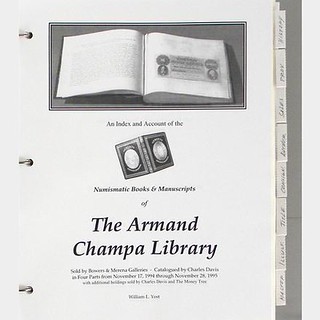 Two three-ring binders including the following: a postcard from George F. Kolbe announcing that he will be offering the Champa Library at auction; promotional materials for the November 1994 Baltimore show at which the first Champa sale was held by Bowers & Merena; the Bowers & Merena announcement of the Champa Library sale; Wayne Homren's invoice for sets of both the softcover and hardcover catalogues; Homren's annotated copies of the first two Champa sales, hand-priced and generally recording buyer numbers, some of which are identified; a copy of the Herman Halpern sale held March 24–25, 1995 alongside the second Champa sale; printed emails and other correspondence regarding the sales, between Homren and John J. Ford, Jr., Chris Karstedt and others; Homren's bid card, handwritten notes, additional printed emails (Wayne was a trend-setter), Champa bookplates, lists of bidders, and so on.
Two three-ring binders including the following: a postcard from George F. Kolbe announcing that he will be offering the Champa Library at auction; promotional materials for the November 1994 Baltimore show at which the first Champa sale was held by Bowers & Merena; the Bowers & Merena announcement of the Champa Library sale; Wayne Homren's invoice for sets of both the softcover and hardcover catalogues; Homren's annotated copies of the first two Champa sales, hand-priced and generally recording buyer numbers, some of which are identified; a copy of the Herman Halpern sale held March 24–25, 1995 alongside the second Champa sale; printed emails and other correspondence regarding the sales, between Homren and John J. Ford, Jr., Chris Karstedt and others; Homren's bid card, handwritten notes, additional printed emails (Wayne was a trend-setter), Champa bookplates, lists of bidders, and so on.
Also included is Bill Yost's third draft and preliminary layout of his unpublished Index and Account of the Numismatic Books & Manuscripts of the Armand Champa Library (dated November 2, 1996). Materials generally fine or nearly so. A fascinating group of ephemeral items relating to the Armand Champa Library sales, accompanied by annotated catalogues and Homren's notes made in preparation for, and immediately after, the sales. Included in the more ephemeral items are printed 1995 emails from the new BiblioNumis-L list being promoted by Harry Bass and Wayne Homren. Yost's never-published work was envisioned to include a history of the collection, provenances, author and dealer index, consignor index, title index, index of illustrations, and a master index. Ex Wayne Homren Library.
With an estimate of $300, this lot hammered at $375. -Editor
To read the complete lot description, see:
Armand Champa Library Materials
(https://bid.numislit.com/lots/view/1-91D1KD/armand-champa-library-materials)
 Lot 323: Connecticut Fiscal Paper
Connecticut. TREASURY OFFICE TRANSFER CERTIFICATE DATED JANUARY 4, 1790 IN INK. Anderson CT 27. Printed form [approximately 19 by 16 cm] filled out by hand, recording the transfer by Joshua Griggs of old notes for new ones. No. 1759; dated January 4, 1790 (printed 1789 date scratched out); signed by Treasurer Peter Colt, with previous signature of Jedediah Huntington crossed out. Docketed on verso. Folded. Very good or better. A piece of 18th-century Connecticut fiscal paper, recording the transfer from Joshua Griggs of
Lot 323: Connecticut Fiscal Paper
Connecticut. TREASURY OFFICE TRANSFER CERTIFICATE DATED JANUARY 4, 1790 IN INK. Anderson CT 27. Printed form [approximately 19 by 16 cm] filled out by hand, recording the transfer by Joshua Griggs of old notes for new ones. No. 1759; dated January 4, 1790 (printed 1789 date scratched out); signed by Treasurer Peter Colt, with previous signature of Jedediah Huntington crossed out. Docketed on verso. Folded. Very good or better. A piece of 18th-century Connecticut fiscal paper, recording the transfer from Joshua Griggs of Army Notes
due June 1, 1785 and June 1, 1787, plus Notes issued February 1781 and May 1783, For which he is entitled to receive Certificates in pursuance to an Act of the General Assembly passed in May 1789.
Ex Wayne Homren Library.
With an estimate of $150, this lot hammered at $300. Glad to know another collector appreciates it. Great ephemera. -Editor
To read the complete lot description, see:
Connecticut Fiscal Paper
(https://bid.numislit.com/lots/view/1-91D1LH/connecticut-fiscal-paper)
Lot 354: Mysterious American Numismatic Rarity Franklin, C.W. A HANDBOOK OF AMERICAN, GREEK AND ROMAN COINS. Bellevue, 1907. Small 8vo, original brown pebbled cloth, gilt. 119, (1) pages; illustrated throughout, including on variously numbered and unnumbered plates. Spine a bit rubbed, else near fine.
The first copy we have ever handled of this virtually unknown book. John Lupia has investigated the author, Calvin Westley Franklin (1854–1911), and has compiled what information he was able to find about him on his website numismaticmall.com. The rarity of this book is a mystery, given that it includes what appear to be paid advertisements from various banks and businesses, including coin dealers S.H. Chapman and A.C. Gies. One would assume that copies would at the very least have been distributed through these channels, but this appears not to be the case. The unusual mix of coverage (ancient coins and modern American coins) may have contributed to the lack of interest among collectors. While I have not had a chance to investigate the illustrations used in this book, they look familiar and I would not be at all surprised to find them elsewhere. An intriguing volume. Ex John Beck Library; ex Wayne Homren Library.
With an estimate of $300, this lot hammered at an amazing $1,300! Everyone loves a mystery, I guess. Pete Smith shed some light on the publisher in our June 16th issue, but this remains somewhat of a puzzle. -Editor
To read the earlier E-Sylum article, see:
CALVIN WESLEY FRANKLIN (1855-1911)
(https://www.coinbooks.org/v27/esylum_v27n24a09.html)
To read the complete lot description, see:
Mysterious American Numismatic Rarity
(https://bid.numislit.com/lots/view/1-91D1N7/mysterious-american-numismatic-rarity)
Lot 359: Hardcover Gilbert & Elder on 1796 Cents Gilbert, E., and Thomas L. Elder. THE VARIETIES OF THE UNITED STATES CENTS OF 1796. New York, 1909. 4to, original brown cloth, gilt. (16) pages (last leaf blank); 2 fine photographic plates of cents. Three printed supplement sheets, describing varieties 22–31 and 33–40 (skipping 32), laid in. Hinges a bit weak, but holding; Very good or better. A nice copy of the Special Hardbound Edition. One of only 300 copies printed, most of which were bound in card covers.
In a letter sold in our June 1990 Adams sale, George Clapp wrote: Rud Kohler wrote me that Gilbert once told him that he had loaned his manuscript of 1796 to Elder who wished to look it over, and the first thing he knew, Elder had published it without consulting him.
Sheldon confirms this and notes that Gilbert had the material for a first-rate monograph. It was either not ready or not intended for publication and was badly edited.
This copy includes all three printed supplements, covering variety Nos. 22–25, 26–31 and 33–40. Somehow, No. 32 was never printed. Ex Dr. James O. Sloss Library; ex Wayne Homren Library.
With an estimate of $150 and starting bid of $100, this one didn't sell. Go figure. That happened more than once, but the market is ever-changing and sometimes an overlooked lot will sell briskly in a later offering. -Editor
To read the complete lot description, see:
Hardcover Gilbert & Elder on 1796 Cents
(https://bid.numislit.com/lots/view/1-91D1NH/hardcover-gilbert-elder-on-1796-cents)
Lot 383: Rare 1866 Cincinnati Coin Sale Broadside Hubbard, S.G. [auctioneer]. COINS, BOOKS, &C. AT AUCTION. ON FRIDAY EVENING, NOVEMBER 9TH, 1866, AT 7 O'CLOCK, WILL BE SOLD THE CABINET OF COINS AND A PORTION OF THE PRIVATE LIBRARY OF THE LATE DR. G.T. COLLINS. THE COINS CONSIST OF AMERICAN, ENGLISH, ROMAN AND GRECIAN, COPPER AND SILVER, SOME OF WHICH ARE RARE. AMONG THE BOOKS ARE SOME THAT ARE RARE AND VALUABLE. ALSO, A GOLD WATCH, MAGNIFYING GLASSES, &C. (Cincinnati), November 9, 1866. Broadside [approximately 48.5 by 32 cm]. 209 numismatic lots + (54) lots of books, etc. Attractively framed in brown wood with gilt interior border using museum glass. Four fold-marks; some browning. Very good or better.
 A marvelous numismatic broadside, already attractively framed and ready to serve as wall decoration for the dedicated coin collector or numismatic bibliophile. American coins in the sale include an assortment of colonials and state coppers, Washingtonia, a run of half cents (including 1811) and a
A marvelous numismatic broadside, already attractively framed and ready to serve as wall decoration for the dedicated coin collector or numismatic bibliophile. American coins in the sale include an assortment of colonials and state coppers, Washingtonia, a run of half cents (including 1811) and a Martha Washington Half Dime.
A run of Roman portrait coins are included, many of them in silver; as well as Greek coins, including two in gold. English coins, from the Anglo-Saxon period to Victoria, followed. Two numismatic works are featured in the book section, Dickeson's American Numismatic Manual and Humphrey's Coin Collector's Manual.
The only other copy of this broadside that we have handled was in the second Bass sale (Kolbe Sale 77, lot 342), where an example brought $2400 hammer. We know of no other copy having been sold, with the Fuld, Champa, Ford and Newman Libraries all lacking a copy. The ANS Library holds the only other copy known to us, and that is permanently off the market. Attinelli 45. McKay 10166.
With an estimate of $750, this lot hammered at $1,200. The buyer contacted me after the sale - they also won the A. C. Gies copy of the Parmelee sale catalogue (Lot 430 sold for $2,250). Great taste, I have to say - these were among my favorites. -Editor
To read the complete lot description, see:
Rare 1866 Cincinnati Coin Sale Broadside
(https://bid.numislit.com/lots/view/1-91D1OT/rare-1866-cincinnati-coin-sale-broadside)
Lot 421: The Donald M. Miller Archives Miller, Donald M. ARCHIVAL MATERIAL INCLUDING ANNOTATED PUBLICATIONS FROM THE LIBRARY OF DONALD MILLER. Includes:
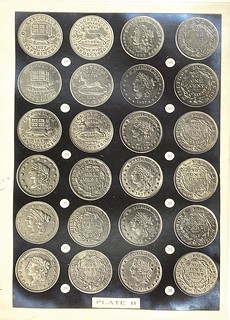 a early binder containing 54 sheets, being a typewritten catalogue of Pennsylvania tokens, almost certainly not by Miller, with handwritten notes by Miller expanding the original text;
a early binder containing 54 sheets, being a typewritten catalogue of Pennsylvania tokens, almost certainly not by Miller, with handwritten notes by Miller expanding the original text;
a binder containing 61 sheets of handwritten notes by Miller on 19th-century American political tokens;
Joseph Barnet's copy of the 1899 second edition of Lyman Low's Hard Times Tokens, acquired by Miller in 1949 from David Bullowa at the same time that Miller acquired Barnet's collection;
a disbound copy of the 1899 second edition of Low, bound with the 1906 supplementary article as published in the American Journal of Numismatics, as well as W.F. Dunham's Instant Finding List, notes on the Levick sale, and an original set of Edgar Adams's 15 Photographs of Hard Times Tokens, Numbered According to Low (c. 1913);
Thomas H. Isitt's lightly annotated copy of the 1899 second edition of Low, bound in leather with the 1906 Supplement;
correspondence between Donald Miller and Charles Kappan, E.E. Rogers, E.A. Rice, Charles McSorley, William Dewey, James Fawcet and others;
miscellaneous notes on varieties of American tokens, with pricing information; notes on collections of tokens and published materials about them;
an inventory of Miller's numismatic library;
a worn copy of the April 1870 issue of the American Journal of Numismatics, including J.N.T. Levick's early Description of the Hard Times Tokens of 1837.
Condition varies, with some of the material in binders coming loose. Generally very good or better unless otherwise noted.
Donald Miller is probably best-known for being the author of A Catalogue of U.S. Store Cards or Merchants Tokens (1962), which was a revision and expansion of Edgar Adams's earlier work on the subject. Miller formed extraordinary collections of American tokens, most particularly Hard Times Tokens and 19th-century store cards. His interest was broad, however, and there are materials here relating to Washingtonia, shell cards, politicals,
and other tokens. His collections were mostly sold privately, and his printed publications are few in number, making this small archive of considerable interest to the token specialist. Ex Donald M. Miller Library; ex Wayne Homren Library.
With an estimate of $750, this lot hammered at $500. A nice group of material. -Editor
To read the complete lot description, see:
The Donald M. Miller Archives
(https://bid.numislit.com/lots/view/1-91D1QX/the-donald-m-miller-archives)
Lot 433: Fantastic 1804 Dollar Signed by All Four Authors & Researchers
Newman, Eric P., and Kenneth E. Bressett. Associates in Research, Walter H. Breen and Lynn Glaser. THE FANTASTIC 1804 DOLLAR. Second printing. Racine: Whitman, 1962. 8vo, original brown textured cloth lettered in silver. 144 pages; illustrated. Signed by all four authors and associates on the title page. Fine. The only copy we recall handling that has been signed by all four authors and associates in research
: Newman, Bressett, Breen and Glaser. Laid in is a printout of an email exchange between Ken Bressett and Wayne Homren, discussing this copy. Ex Wayne Homren Library.
With an estimate of $150, this lot hammered at a whopping $3,250, the second highest price in my consignment after the Howard Gibbs archive (Lot 183 hammered at $3,750). Hotly contested, this is a wonderful association item and I'm gratified that it's as valued by the market as it was by me - it was another of my favorites. -Editor
To read the complete lot description, see:
Signed by All Four Authors & Researchers
(https://bid.numislit.com/lots/view/1-91D1RL/signed-by-all-four-authors-researchers)
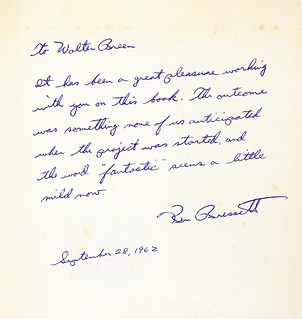 Lot 434: Walter Breen's Inscribed Copy
Newman, Eric P., and Kenneth E. Bressett. Associates in Research, Walter H. Breen and Lynn Glaser. THE FANTASTIC 1804 DOLLAR. Second printing. Racine: Whitman, 1962. 8vo, original brown textured cloth lettered in silver. 144 pages; illustrated. Signed, with a lengthy inscription, to Walter Breen by Ken Bressett on the front flyleaf. Minor spotting; somewhat musty. Very good. An important association copy, inscribed by author Ken Bressett of Water Breen, who is named on the title page along with Lynn Glaser as an
Lot 434: Walter Breen's Inscribed Copy
Newman, Eric P., and Kenneth E. Bressett. Associates in Research, Walter H. Breen and Lynn Glaser. THE FANTASTIC 1804 DOLLAR. Second printing. Racine: Whitman, 1962. 8vo, original brown textured cloth lettered in silver. 144 pages; illustrated. Signed, with a lengthy inscription, to Walter Breen by Ken Bressett on the front flyleaf. Minor spotting; somewhat musty. Very good. An important association copy, inscribed by author Ken Bressett of Water Breen, who is named on the title page along with Lynn Glaser as an Associate in Research.
Bressett's inscription, dated September 28, 1962, reads, To Walter Breen, It has been a great pleasure working with you on this book. The outcome was something none of us anticipated when the project was started, and the word ‘fantastic' seems a little mild now.
Ex Wayne Homren Library.
With an estimate of $100, this lot hammered at $300. The condition "Minor spotting; somewhat musty" probably played a factor, but to me that was part of the Breen charm. -Editor
To read the complete lot description, see:
Walter Breen's Inscribed Copy
(https://bid.numislit.com/lots/view/1-91D1RN/walter-breens-inscribed-copy)
Lot 455: An A.M. Smith Corkscrew
Smith, A.M. STRAIGHT-PULL CORKSCREW WITH WOODEN GRIP ADVERTISING A.M. SMITH'S WINE AND SPIRITS BUSINESS. Minneapolis, late 1800s–early 1900s. 11.5 cm iron shaft with 9 cm wooden grip. Printed text promoting Smith's business at 247–249 Hennepin Avenue, Minneapolis. Shaft lightly rusted; grip text legible. Very good. A neat memento of one of the more prominent American numismatic authors of the later 19th century. According to Pete Smith's American Numismatic Biographies, A.M. Smith moved to Minneapolis in 1886, where he engaged successfully in the wine trade. The wooden grip of this promotional corkscrew advertises the availability of Wines, Brandies, Whiskies, Pure Olive Oil, Honey, Ale, Porter, Beer, Cigars.
Ex Wayne Homren Library.
With an estimate of $100, this association item hammered at $65. A gift from Pete Smith, Pete also provided some additional background in a subsequent article. -Editor
To read the earlier E-Sylum article, see:
THE COLLECTOR'S DISPOSITION DILEMMA
(https://www.coinbooks.org/v27/esylum_v27n25a11.html)
To read the complete lot description, see:
An A.M. Smith Corkscrew
(https://bid.numislit.com/lots/view/1-91D1ST/an-am-smith-corkscrew)
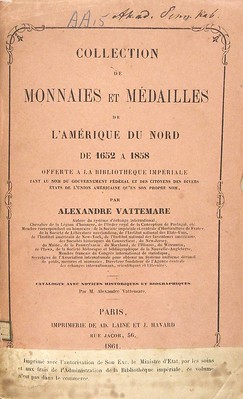 Lot 486: Signed by Vattemare
Vattemare, Alexandre. COLLECTION DE MONNAIES ET MÉDAILLES DE L'AMÉRIQUE DU NORD DE 1652 À 1858, OFFERTE A LA BIBLIOTHÈQUE IMPÉRIALE TANT AU NOM DU GOUVERNEMENT FÉDÉRAL ET DES CITOYENS DES DIVERS ÉTATS DE L'UNION AMÉRICAINE QU'EN SON PROPRE NOM... CATALOGUE AVEC NOTICES HISTORIQUES ET BIOGRAPHIQUES. Paris: Imprimerie de Ad. Lainé et J. Havard, 1861. 12mo, later black quarter morocco with marbled sides; spine ruled and lettered in gilt; original printed paper covers, with printed hors commerce label, bound in. 134, (2) pages. Original postal wrap showing the address of P.O. van der Chijs, signed by Vattemare and bearing the ink stamp of the Systèm International and the handwritten postage paid, trimmed and mounted to opening blank. Very good or better; binding fine. A fascinating copy, this was sent by Vattemare to Dutch numismatist Pieter Otto van der Chijs...
Lot 486: Signed by Vattemare
Vattemare, Alexandre. COLLECTION DE MONNAIES ET MÉDAILLES DE L'AMÉRIQUE DU NORD DE 1652 À 1858, OFFERTE A LA BIBLIOTHÈQUE IMPÉRIALE TANT AU NOM DU GOUVERNEMENT FÉDÉRAL ET DES CITOYENS DES DIVERS ÉTATS DE L'UNION AMÉRICAINE QU'EN SON PROPRE NOM... CATALOGUE AVEC NOTICES HISTORIQUES ET BIOGRAPHIQUES. Paris: Imprimerie de Ad. Lainé et J. Havard, 1861. 12mo, later black quarter morocco with marbled sides; spine ruled and lettered in gilt; original printed paper covers, with printed hors commerce label, bound in. 134, (2) pages. Original postal wrap showing the address of P.O. van der Chijs, signed by Vattemare and bearing the ink stamp of the Systèm International and the handwritten postage paid, trimmed and mounted to opening blank. Very good or better; binding fine. A fascinating copy, this was sent by Vattemare to Dutch numismatist Pieter Otto van der Chijs...
Vattemare's System of International Exchanges was initially aimed at the exchange of duplicate books between libraries, and was later extended to include works of art, maps, natural history specimens, coins, medals and other similar objects. He came to America in 1839 and again in 1847, and was granted funds by Congress and by several state legislatures to further his scheme, which met with greater success here than in Europe. This elusive 1861 work describing American coins, medals and tokens from 1652 to 1858 was written to complement the collection given to the Bibliothèque Impériale (Nationale) in the name of the government and citizens of the United States. Following an interesting historical overview, from colonial issues to pioneer gold, some 381 pieces are described in detail. P.O. van der Chijs was the foremost Dutch numismatist of his day; some of the pencil annotations record additional American coins in the numismatic cabinet at Leiden.
Alexandre Vattemare is recognized among American numismatists as one of the fathers of the discipline in the New World, having assembled the first comprehensive collections of American coins, medals, and paper currency, and produced the first comprehensive catalog of American numismatics.
— Alan Stahl, in The Extravagant Ambassador: The True Story of Alexandre Vattemare, the French Ventriloquist Who Changed the World. Ex P.O. van der Chijs Library; ex Schulman Numismatic Library; George F. Kolbe 1997 fixed price list; ex Wayne Homren Library.
This lot was overlooked in the first sale of my consignment, and didn't sell, but the second time was a charm in this case. With an estimate of $300, this lot hammered at $500. Great purchase from a 1997 George F. Kolbe fixed price list. -Editor
To read the complete lot description, see:
Signed by Vattemare
(https://bid.numislit.com/lots/view/1-91D1UJ/signed-by-vattemare)
I'll miss having these on my shelves, but I know they've found some great new homes. -Editor
To read the earlier E-Sylum article, see:
WAYNE'S NUMISMATIC LITERATURE JUNE 9, 2024
(https://www.coinbooks.org/v27/esylum_v27n23a19.html)
A SILVER LIBERTAS AMERICANA MEDAL
I shrug when a common modern coin is touted as the "Finest Certified". But an historically important rarity is another story. Stack's Bowers Galleries Numismatist Chris Bulfinch wrote this short article about a wonderful silver Libertas Americana medal. -Editor
The Libertas Americana medal is legendary and, to no one's surprise, it was chosen as #1 in the 100 Greatest Medals and Tokens book. Its classical imagery heralds the U.S. victory in the Revolutionary War and France's role in the conflict. The profile of Liberty on the obverse and Minerva's defense of the infant Hercules on the reverse are designs instantly familiar to students of early American numismatic history and have been reproduced countless times, using original dies and recreations of varying quality. Stack's Bowers Galleries is proud to offer the sole finest PCGS-certified original 1783 Libertas Americana medal in silver in the August 2024 Global Showcase Auction.
Commissioned in 1782 to celebrate the fledgling United States' victory over the British and the contributions of the French to the war effort, Libertas Americana medals were designed by Augustin Dupree and first produced in Paris in 1783. The concept and mottos displayed by this medal are attributed to Benjamin Franklin, who at the time was serving as U.S. commissioner to France. The obverse portrait would later influence some of the first renditions of Liberty to appear on United States coinage, specifically on the Liberty Cap copper coinage and the Flowing Hair silver coinage. The reverse design is highly symbolic, the two serpents representing the American victory over the British at the battles of Saratoga and Yorktown, but Minerva keeping the British lion at bay confirming that American independence would not have been possible without French aid. The dates in exergue on the reverse are the dates of the victories over General John Burgoyne at Saratoga and General Charles Cornwallis at Yorktown. The Original 1783 Libertas Americana medal is known in silver and bronze. Silver examples were presented to members of Congress, King George III's government, and other notables and are rarer than the bronze versions.
Cataloged as Adams-Bentley 15, Betts-615, original Libertas Americana medals attract considerable collector attention when they come up for auction. Not only is this Libertas Americana the finest certified by PCGS at MS-64+, but it is also new to the modern market, having been purchased from Stack's Rare Coins about two decades ago. It sports original surfaces with beautiful toning; the devices display shades of cyan on the obverse and hints of peach along the bottom. Peach hues highlight Minerva and the baby Hercules on the reverse, while pale blue is seen in the fields and electric blue along the edge.
This exceptional piece will be featured in the Stack's Bowers Galleries August Global Showcase scheduled for August 12-16 & 19-22 in Costa Mesa, California. Lot viewing for the sale will be available at the ANA World's Fair of Money in Rosemont, Illinois August 4-9. For more information contact Stack's Bowers Galleries by phone at 800-458-4646 or by email at Info@StacksBowers.com.
To read the complete article, see:
SILVER LIBERTAS AMERICANA MEDAL GRADED PCGS MS-64+ FEATURED IN AUGUST GLOBAL SHOWCASE AUCTION
(https://stacksbowers.com/silver-libertas-americana-medal-graded-pcgs-ms-64-featured-in-august-global-showcase-auction/)
PISTRUCCI'S WATERLOO MEDAL
Benedetto Pistrucci's Waterloo Medal is a pinnacle of numismatic art, with a long, tortured and celebrated history. The Royal Mint has issued a reproduction in its Great Engravers Collection. Their website has an article breaking down the major elements of the intricate work's design. -Editor
The development of the Waterloo Medal has been well documented, both through The Royal Mint's archives and external sources. A design imbued with intricacy and ornate detail, it is understandable how it could take an artist three decades to perfect, especially one so committed to originality as Benedetto Pistrucci. However, there were external factors which influenced the painstakingly slow progress of the highly anticipated medallion. Despite assuming the responsibilities of Chief Engraver and carrying out many of the duties associated with the role, Pistrucci could never fulfil the role in an official capacity due to a law decreed by William III, which debarred a foreigner from assuming the position. His frustration was even more exacerbated when William Wyon RA, who once served as Pistrucci's junior, assumed the role of Chief Engraver, with the Italian given the position of Chief Medallist. Embittered at what had occurred, Pistrucci played an active role in slowing the work on the medal to ensure his financial security, despite insisting to William Gladstone, then Master of the Mint, ‘it is impossible there can be in this world any one individual more anxious than myself, to see the Waterloo Medal finished.'
Following a suggestion from his younger brother, the Duke of Wellington, William Wellesley Pole approached Pistrucci to create designs for a medal commemorating the Battle of Waterloo. The work began in 1819 but it wasn't until 1849 that the dies were delivered to The Royal Mint. They were so large they couldn't be hardened, so the medal was never physically struck, and the electrotypes were the only fruit of Pistrucci's 30-year labour.
Nevertheless, these electrotypes bore the medal's design, which is one of inimitable intricacy and consummate detail. Layered with allegorical meaning, the artist has interpreted the Battle of Waterloo through a classical lens, as the design entwines gods and figures from Greek mythology with the events of the battle itself.
The general design of the medal is treated allegorically, except the central part of the obverse, which represents the busts of the four allied monarchs, seen grouped in profile to the left: George, Prince Regent; Francis II (Emperor of Austria); Alexander I (Emperor of Russia); and Frederick William III (King of Prussia). An array of figures feature in the border framing these portraits, in a thoughtfully constructed tapestry which constitutes an allegorical and mythological allusion to the Treaty of Peace which resulted from the great triumph in the field of battle.
Apollo is presented at the top of the obverse in his quadriga restoring the day.
The chariot hurtles towards the constellation Gemini and therefore symbolises the month in which the great contest took place. Castor and Pollux, with spears, represent the apotheosis of Wellington and Blücher; Themis, the goddess of Justice, appears on earth, as in the golden age.
To read the complete article, see:
The Making of a Medallic Masterpiece
(https://www.royalmint.com/stories/commemorate/the-making-of-a-medallic-masterpiece/)
For more on The Great Engravers Collection, see:
https://www.royalmint.com/great-engravers/
AUGUSTUS SAGE'S CYRUS FIELD MEDAL
Another article by Stack's Bowers Galleries Numismatist Chris Bulfinch discusses the Cyrus Field medal produced by Augustus B. Sage. -Editor
Augustus B. Sage is an important name in U.S. numismatic history. A cofounder of the American Numismatic Society, coin dealer, medal publisher, and veteran who worked in a variety of fields through his short life, Sage was one of the first prominent American numismatists in an era when the hobby was catching on in the country. He published medal series bearing his name beginning in the late 1850s through the 1870s. The first medallic appearance of his name came in 1858 when he published a medal, designed by George Hampden Lovett, honoring Cyrus W. Field, an American paper merchant and financier who spearheaded efforts to lay a transatlantic telegraph cable in the mid-19th century.
Cyrus Field joined the efforts to create a transatlantic telegraph in 1853, and on August 16, 1858 he sent the first official message across the wire. Queen Victoria and President James Buchanan exchanged transatlantic telegraph messages the same day.
Augustus B. Sage, 17 years old when those telegraphs were sent in 1858, was already making a name of himself in the burgeoning New York City numismatic community of the mid-19th century. He commissioned medals celebrating Field and the completion of the transatlantic cable. George Hampden Lovett, a New York City-based diesinker (who would have a long association with Sage and the ANS), prepared an obverse die depicting Field in classical garb encircled by an oak wreath and a simple reverse with text commemorating the completion of the cable encircled by a laurel wreath on its reverse. Two reverse dies were employed, differentiated by the Latin motto surrounding the reverse wreath. Silver and coppered bronze medals were produced.
The Transatlantic Cable only operated for a month before failing; the successful laying of a second cable in 1866 inspired more commemorative medals.
Q. David Bowers' 1998 book American Numismatics Before the Civil War, 1760-1860: Emphasizing the Story of Augustus B. Sage paints a helpful picture of the nascent coin hobby at midcentury and offers valuable details about Sage's life.
Second mention in this issue of Dave Bowers' great book American Numismatics Before the Civil War, 1760-1860. If you don't have a copy, get one. Important hobby history.
As a fan of the history of business, science and technology, Cyrus Field is one of those massively important heroes whose names are unfortunately little known today. Others include John Harrison, Clarence Birdseye, Norman Borlaug, Alan Turing, John von Neumann and Claude Shannon. -Editor
To read the complete article, see:
DID YOU KNOW THAT AUGUSTUS B. SAGE'S NAME FIRST APPEARED ON A MEDAL HONORING CYRUS W. FIELD IN 1858?
(https://stacksbowers.com/did-you-know-that-augustus-b-sages-name-first-appeared-on-a-medal-honoring-cyrus-w-field-in-1858/)
FASCINATED BY OLD STOCK CERTIFICATES
This article by Peter Longini at the Pittsburgh Post-Gazette surveys the field of scripophily, the study and collecting of stock certificates. Here's an excerpt - see the complete article online. -Editor
OK, I'll admit it. For some years now, I have been practicing scripophily. And for just as long, I have felt uncomfortable sharing that fact about my life with acquaintances.
To the ears of many people, it sounds like something that should only take place among consenting adults or as an activity that may not be legal in Florida. In any case, it isn't something you routinely see people around you practicing. But I'd like to clear the air and get this matter off my chest.
Although I admit that its most passionate participants are all over 60, scripophily is actually a specialized collector's interest, not an exotic fetish. It is a bit like stamp, coin or currency collecting, but it's focused instead on stock certificates.
Between the 18th and 20th centuries, investors were issued elaborate documents to certify their share of ownership in a company. These documents, called stock certificates, would typically include highly detailed engravings that made them difficult to counterfeit. Those engravings frequently depicted images of corporate mythology – allegorical vignettes of gods and goddesses symbolically representing the issuing company and its industry.
But many of those old certificates, although worthless on the stock exchanges, have now become collectors' items. And in that capacity, their value to collectors is determined by factors such as rarity, condition, signatures, notoriety and so on. Taken together, these certificates offer a unique look at the evolution of various industries as well as an idealized view of their companies' contributions to the economy.
My own collection began almost 50 years ago when I came across a bin in an antique store with stock certificates from a handful of privately owned trolley companies – companies which were eventually absorbed into the Port Authority of Allegheny County, now Pittsburgh Regional Transit. That, in turn, led me into collecting railroad stock certificates. At one time or another, there were approximately 1,700 different passenger and freight rail lines issuing stock to raise capital in the United States alone.
From there, my collecting attention turned in all sorts of quirky directions: automobiles, mines, utilities, Pittsburgh-based companies, financial services and so on. Today, there are more than 600 certificates in my collection.
But the elements that catch the eye more than any other have had less to do with their specific industries than with their vignettes. Many depict muscular men and attractive women dressed only in loin cloths – images which, although probably inspired by classical Greek statuary, were almost certainly regarded as risqué by 19th and early 20th century standards.
To read the complete article, see:
Caught in the act of scripophily, he's fascinated by old stock certificates
(https://www.post-gazette.com/life/goodness/2024/06/18/scripophily-antique-stock-certificates-peter-longini/stories/202406220001)
A VENDING MACHINE FOR MONEY
In the history-of-great-ideas department, here's the story of WWII vet John Shepherd-Barron, who dreamed up a vending machine for cash - the automated teller machine, or ATM. -Editor
After the war was over, Shepherd-Barron came home to the U.K., where he wound up in the management trainee program at a company called De La Rue Instruments. He worked hard, drew a paycheck, and formed a habit of cashing the check each Friday at the same time.
Then, one Friday in 1965, he was delayed, and he arrived at the bank one minute after it closed. Stuck without cash for the weekend, he went home, drew a bath, and contemplated his dilemma.
"It struck me there must be a way I could get my own money, anywhere in the world or the UK," he recalled long afterward. "I hit upon the idea of a chocolate bar dispenser, but replacing chocolate with cash."
Yes, John Shepherd-Barron is the person credited with inventing the automated teller machine, or ATM, which debuted 57 years ago ... in England -- long before it hit the United States, by the way.
What's wild is that Shepherd-Barron wasn't in the banking industry or an accomplished inventor. But, a few months after his bathtub epiphany, he arranged to run into the chief general manager of Barclay's Bank.
The Telegraph picked up the story here, after Shepherd-Barron's death in 2010:
"Over a pink gin, Shepherd-Barron asked him for 90 seconds to pitch his idea for a cash machine. ?
I told him I had an idea that if you put your standard Barclays cheque through a slot in the side of the bank, it will deliver standard amounts of money around the clock. ?
He said, 'Come and see me on Monday morning.'""
Sadly, this is apparently another instance of someone inventing something incredibly useful but never getting much in the way of financial reward as a result.
However, he received all kinds of honors for his work, and he apparently lived a long and happy life. And for that reason, I think we'll end with a quote from him about when he realized the reach of what he'd created.
It came years later when he was visiting Thailand, and he watched a farmer roll up to an ATM on an ox-driven cart, remove his wide-brimmed hat, and withdraw cash:
"It was the first evidence to me that we'd changed the world."
See the earlier E-Sylum articles and Wikipedia for other ATM milestones. -Editor
To read the complete article, see:
Replacing chocolate with cash
(https://ckarchive.com/b/4zuvheh545n89a6ovveola30rvv77t5?lctg=gxw9m343)
To read earlier E-Sylum articles, see:
HAPPY BIRTHDAY TO THE AUTOMATED TELLER MACHINE
(https://www.coinbooks.org/esylum_v10n29a20.html)
ATM MAKER EXPERIMENTING WITH RETINA SCANNER
(https://www.coinbooks.org/esylum_v18n45a33.html)
The Dawn of the Reverse ATM
(https://www.coinbooks.org/v23/club_nbs_esylum_v23n42.html)
ATMS DISAPPEARING ALONG WITH CASH USAGE
(https://www.coinbooks.org/v26/esylum_v26n10a29.html)
To read the earlier E-Sylum article, see:
Automated teller machine
(https://en.wikipedia.org/wiki/Automated_teller_machine)
LOOSE CHANGE: JUNE 30, 2024
Here are some additional items in the media recently that may be of interest. -Editor
Dick Hanscom passed along this item on a judge's 300-year sentence for three murders in the commission of a coin shop robbery. -Editor
Alaska Superior Court Judge Jack McKenna sentenced Anthony Pisano, 50, to 300 years for the triple homicide in the Bullion Brothers store on Spenard Road in Anchorage on Sept. 12, 2017.
This was the maximum sentence allowable under the law and included three 99-year sentences for each murder victim and a five-year sentence for the assault of Michael Dupree, with two years running concurrently. The murder victims included Bullion Brothers store owner, Steven Cook, and residents Daniel McCreadie and Kenneth Hartman.
To read the complete article, see:
ANTHONY PISANO SENTENCED Counterfeit Banknotes in AustraliaTO 300 YEARS FOR 2017 SHOOTING DEATHS
(https://www.anchoragepolice.com/news/anthony-pisano-sentenced-to-300-years-for-2017-shooting-deaths)
Ron Guth published a short video on an interesting livestock medal. -Editor
To watch the complete video, see:
1884 Scottish Livestock Silver Medal
(https://www.youtube.com/shorts/qS6I6rylCc8)
Here's the second part of Roger Burdette's CoinWeek series on the making of the Peace dollar. Here's a short excerpt - see the complete article online. -Editor
A decade earlier in 1910, Congress had passed legislation creating the Commission of Fine Arts to advise on matters involving art and architecture in the District of Columbia and executive departments of the United States Government. The commission, operating with support from the Army Corps of Engineers and other agencies, routinely reviewed plans for public buildings, fountains, statues, medals, coins, and other public objects, and provided suggestions to the designers and artists involved.
Although it did not officially approve
designs, the Commission's recommendation was seldom ignored; members often worked directly with architects and artists to modify and perfect their designs.
The support of Chairman Charles Moore was especially important for any artist aspiring to work on a government-funded project. Included in the Commission's authority was the implicit ability to arrange competitions for the design of government medals, insignia, and coins, among other things. The Commission conducted these competitions in cooperation with the appropriate executive department subject to available funding and could choose the artists who would be invited to participate. Recommendations of the Commission were forwarded to the relevant Cabinet secretary for final approval.
Chairman Moore and sculptor-member James Earle Fraser met with United States Mint Director Raymond T. Baker on May 26 to discuss the Congressional Joint Resolution.[2] Baker stated that he wanted to have a Peace Dollar commemorating the end of the war and that the design should be distinctively American.
To read the complete article, see:
Making the Peace Dollar, Part Two: Round of Approval
(https://coinweek.com/making-the-peace-dollar-part-two-round-of-approval/)
To read the earlier E-Sylum article, see:
LOOSE CHANGE: JUNE 16, 2024 : Making the Peace Dollar, Part One
(https://www.coinbooks.org/v27/esylum_v27n24a26.html)
Australian restaurants are getting hit with better currency counterfeits. -Editor
Melbourne hospitality businesses are already doing it tough, with diners spending less and costs soaring. Now restaurateurs also have to worry about counterfeit currency. Twice in the past month, Omar El Deek from South Yarra's Cosi has discovered that customers paid for their meals with fake $50 and $100 notes.
It's never happened before. Both times, my wife counted the money in the office the next morning, and it was clearly fake. You can tell when you look at it properly. The touch is different, the plastic window on the $50 note doesn't have the coat of arms.
El Deek thinks customers at his Italian restaurant were unaware they were carrying counterfeits. I don't believe they were trying to scam us,
he says. The notes were in circulation.
After the second occasion, he bought a detector machine for $300 and is now running every note through it. We take the money off the table, run it through the machine and if it bounces back, we will let the customer know,
he says.
To read the complete article, see:
‘The fakes are getting better': Restaurants hit with counterfeit money crime
(https://www.smh.com.au/goodfood/the-fakes-are-getting-better-restaurants-hit-with-counterfeit-money-crime-20240614-p5jlrc.html)


